Archived Blog Posts
A Comprehensive Guide: How to File a Water Damage Claim
7/24/2023 (Permalink)
 Filing a water loss with insurance can help recover cost associated with your property loss.
Filing a water loss with insurance can help recover cost associated with your property loss.
Experiencing water damage in your home can be a stressful and overwhelming situation. Fortunately, many homeowners' insurance policies cover water damage caused by various factors. Filing a water damage claim can help you recover the costs associated with repairs, restoration, and replacing damaged belongings. In this blog, we will provide a step-by-step guide on how to file a water damage claim to ensure a smooth and successful process.
Assess the Damage and Document
Before contacting your insurance company, thoroughly assess the extent of the water damage. Take detailed photographs or videos of the affected areas, documenting the damage to support your claim.
Make a list of damaged items and gather any relevant receipts or invoices related to repairs or purchases. Maintain a record of all communication with your insurance company. Take note of the dates, times, names of the representatives you speak with, and a summary of the conversations. This documentation will be valuable if any issues arise during the claims process.
Review Your Insurance Policy
Carefully review your homeowners' insurance policy to understand the coverage and exclusions related to water damage. Pay attention to specific terms, limitations, and deductibles. Familiarize yourself with the steps and requirements for filing a claim outlined in the policy.
Notify your insurance company as soon as possible to report the water damage and initiate the claims process. Provide them with essential details, such as the date of the incident, a description of the damage, and the affected areas. Follow their instructions regarding the next steps and documentation they may require.
Mitigate Further Damage
Take immediate action to prevent further damage and protect your property. If safe to do so, address the source of the water leak or shut off the water supply. Remove any standing water and begin the drying process to prevent mold growth and additional structural damage. Keep records of any actions taken to mitigate further damage, including receipts for professional services.
Insurance claims
Your insurance company will likely assign a claims adjuster to evaluate the damage and determine the coverage and reimbursement. Schedule an appointment with the adjuster to inspect the property and provide them with the evidence of the damage, including photographs, videos, and itemized lists.
Obtain multiple repair estimates from reputable contractors or restoration companies. These estimates will help validate the cost of the repairs and provide evidence to support your claim. Share the estimates with the claims adjuster and discuss the scope of the necessary repairs.
Submit the Required Documentation
Follow your insurance company's instructions to submit the necessary documentation for your claim. This typically includes a completed claim form, a detailed description of the damage, itemized repair or replacement costs, receipts, photographs, and any other supporting evidence they require. Ensure that all documentation is accurate, complete, and submitted within the designated time frame.
Review the Settlement Offer
Once your insurance company evaluates your claim, they will provide a settlement offer outlining the coverage and reimbursement they are willing to provide. Carefully review the offer, paying attention to any discrepancies or items that may have been overlooked. If you have concerns or believe the offer is inadequate, discuss it with your claims adjuster or seek professional advice.
Once you accept the settlement offer, proceed with the necessary repairs and restoration work. Retain all receipts, invoices, and documentation related to the repairs, as they will be required for reimbursement. Take photographs of the completed repairs for your records.
Filing a water damage claim can help you recover the costs associated with restoring your property and belongings after a water-related incident. Following this guide you can navigate the claims process effectively and maximize your chances of a successful outcome. Remember, if you have any questions or concerns, don't hesitate to seek guidance from your insurance company or consult with a professional.
Sump Pump Maintenance: Essential Tips for Reliable Performance
6/20/2023 (Permalink)
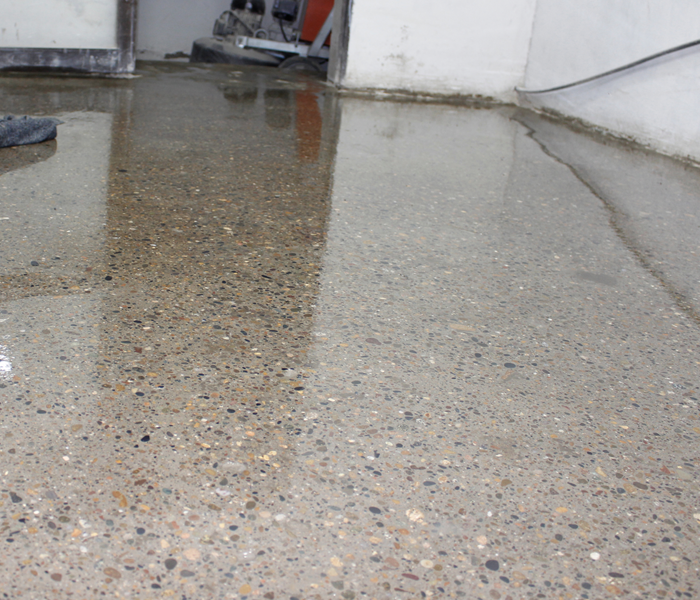 Testing your sump pump regularly to help reduce malfunction when needed.
Testing your sump pump regularly to help reduce malfunction when needed.
A sump pump is a critical component of many homes, helping to prevent water damage by efficiently removing excess water from basements and crawl spaces. To ensure its optimal performance when you need it most, regular maintenance is key. In this blog, we'll explore essential tips for maintaining your sump pump, safeguarding your home from potential water-related issues and promoting peace of mind.
Test Your Sump Pump Regularly
Test your sump pump by pouring water into the sump pit to activate the pump. Ensure that it starts automatically, pumps out the water, and shuts off without any issues. This test verifies that the pump is functioning correctly. To prepare for power outages, unplug your sump pump and simulate a power loss by lifting the float or disconnecting the float switch. Confirm that the backup system (if you have one) engages and operates as expected.
Clean and Maintain the Sump Pit
Regularly inspect and clean the sump pit, removing any debris, dirt, or sediment that may accumulate. This helps prevent clogs and ensures smooth pump operation. Ensure the float is unobstructed and moves freely. Clean or replace the float switch if it appears damaged or worn out.
Test and Maintain the Discharge Line
Regularly check the discharge line for any blockages or obstructions. Remove debris, dirt, or ice buildup that may impede the flow of water away from your home. Direct the discharge line away from the foundation of your home to prevent water from recirculating into the sump pit. Ensure it slopes away from the house to promote proper drainage.
Inspect Check Valves and Backup Systems
Check valves prevent water from flowing back into the sump pit once the pump turns off. Ensure the check valve is properly installed and functioning correctly. If you have a battery-powered backup sump pump or a secondary backup system, test and maintain them according to the manufacturer's instructions. This ensures their readiness during power outages or primary pump failures.
Keep an Eye on Pump Motor and Alarm
Regularly inspect the pump motor for any signs of damage, unusual noises, or overheating. Contact a professional if you notice any issues that require attention. If your sump pump has an alarm system, test it periodically to ensure it functions properly. Clean or replace the batteries as needed.
Consult Professional Services
Consider scheduling professional maintenance for your sump pump. A qualified technician can perform a thorough inspection, clean components, and address any potential concerns. If you encounter persistent issues with your sump pump or require repairs, it's best to consult a professional to ensure proper resolution and optimal performance.
Maintaining a sump pump is crucial for its reliable operation and your home's protection against water damage. By regularly testing, cleaning, and maintaining the sump pit, discharge line, check valves, backup systems, pump motor, and alarm, you can ensure that your sump pump is ready to handle excess water effectively. Remember, professional assistance is available for more comprehensive servicing or troubleshooting. By prioritizing sump pump maintenance, you can enjoy a secure and water-free environment in your home.
Essential Tips for Preventing Mold in Humid Climates: Keep Your Home Mold-Free!
5/17/2023 (Permalink)
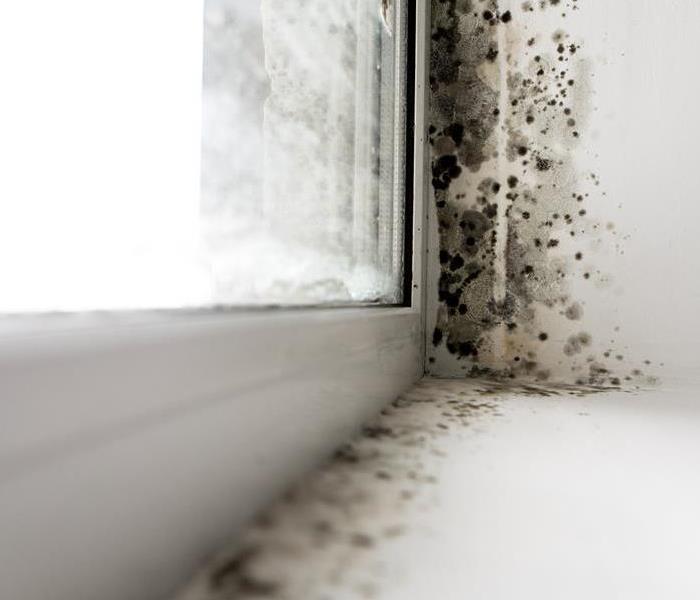 Mold can grow in humid climates and present challenges in your home or business.
Mold can grow in humid climates and present challenges in your home or business.
Living in a humid climate can present challenges, and one of the most common issues homeowners face is mold growth. Mold thrives in damp environments, making humid regions particularly susceptible to this pesky and potentially harmful fungus. However, with the right knowledge and preventive measures, you can effectively prevent mold growth in humid climates and keep your home safe and healthy.
Mold is a type of fungus that can grow indoors and outdoors. It reproduces through spores that are carried through the air and can easily find their way into your home. Once inside, mold can grow on various surfaces, including walls, ceilings, floors, carpets, and even furniture. Mold growth is not only unsightly, but it can also cause health issues such as respiratory problems, allergies, and skin irritation.
So, how can you prevent mold in humid climates? Here are some essential tips to keep your home mold-free:
Control Indoor Humidity
The key to preventing mold in humid climates is to control the indoor humidity levels. Invest in a good quality hygrometer to measure the humidity levels in your home. Ideally, indoor humidity should be kept below 50%. If the humidity levels are high, use dehumidifiers to lower the moisture levels in your home. Make sure to empty and clean the dehumidifier regularly to prevent mold growth within the unit.
Improve Ventilation
Proper ventilation is crucial in preventing mold growth. Make sure your home is well-ventilated by using exhaust fans in bathrooms, kitchens, and laundry rooms. Ensure that your clothes dryer is properly vented to the outside to prevent excess moisture from accumulating indoors. Additionally, open windows and doors to allow fresh air to circulate and reduce humidity levels.
Fix Leaks
Any leaks in your home can quickly lead to mold growth. Regularly check for leaks in pipes, roofs, and windows and promptly fix them to prevent moisture from seeping into your home. If you notice any signs of water damage, such as stains or musty odors, address the issue immediately to prevent mold from taking hold.
Insulate and Seal Your Home
Proper insulation and sealing can prevent moisture from entering your home, helping to keep mold at bay. Insulate your walls, floors, and ceilings, and seal any gaps or cracks in doors, windows, and walls. This will not only help prevent mold growth but also make your home more energy-efficient.
Keep Your Home Clean and Dry
Regular cleaning and maintenance are essential in preventing mold growth. Clean up spills and water leaks immediately, and dry any wet areas promptly. Make sure to clean your home regularly, including carpets, upholstery, and other surfaces, using mold-inhibiting cleaners. Pay special attention to areas that are prone to moisture, such as bathrooms and kitchens.
Avoid Overwatering Indoor Plants
Indoor plants can add beauty to your home, but they can also contribute to mold growth if overwatered. Avoid overwatering your indoor plants and make sure they are well-drained. Use pots with drainage holes and place saucers underneath to catch excess water. Wipe up any spills or standing water promptly.
Use Mold-Resistant Building Materials
When building or renovating your home, consider using mold-resistant building materials. These materials are designed to inhibit mold growth and can be used in areas that are prone to moisture, such as bathrooms and basements. Examples of mold-resistant materials include mold-resistant drywall, paint, and insulation.
Keep Outdoor Areas Well-Maintained
The exterior of your home can also contribute to mold growth indoors. Keep outdoor areas well-maintained by trimming back trees and shrubs away from your home to allow for proper airflow. Clean your gutters regularly to prevent water damage.
Relief for Burns. A Guide to Basic First Aid for Burn Injury.
4/28/2023 (Permalink)
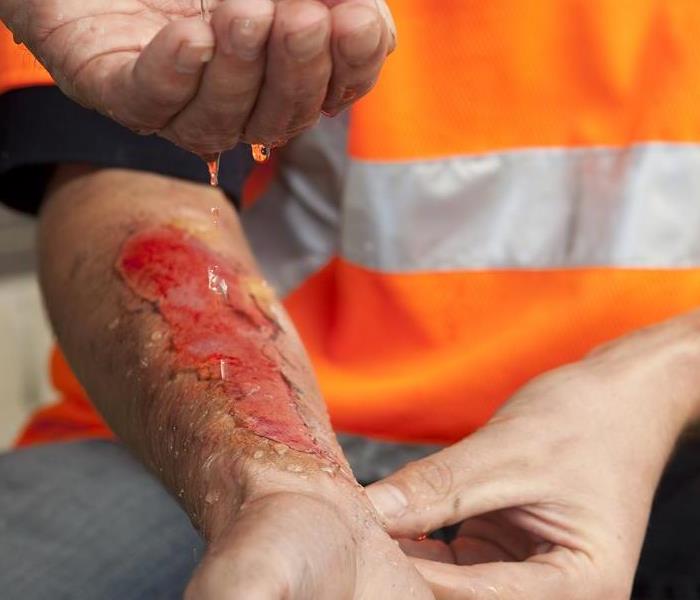 Seeking immediate medical attention to help reduce burn and infection.
Seeking immediate medical attention to help reduce burn and infection.
Burns are one of the most common injuries that people can sustain, both at home and at work. They can be caused by a variety of things, including hot liquids, flames, chemicals, and electricity. While some burns are minor and can be treated at home, others require immediate medical attention. In this blog post, we’ll discuss basic first aid for burns that you can use to help relieve pain and promote healing.
Types of Burns
Before we dive into first aid for burns, it’s important to understand the different types of burns. There are three types of burns:
First-degree burns: These are the mildest type of burns and only affect the outer layer of skin. They’re usually red, painful, and can be treated at home.
Second-degree burns: These affect both the outer and underlying layer of skin. They’re usually red, swollen, and painful. Blisters may also form.
Third-degree burns: These are the most severe type of burns and affect all layers of skin. They can be white or black in color, and the skin may appear leathery or charred. Third-degree burns require immediate medical attention.
First Aid for Burns
For first-degree burns, you can usually treat them at home using the following steps:
Cool the burn: Run cool (not cold) water over the burn for at least 10 minutes to help relieve pain and reduce swelling.
Cover the burn: Apply a sterile gauze bandage or a clean cloth to the burn to help keep it clean and reduce the risk of infection.
Take over-the-counter pain medication: If the burn is painful, take an over-the-counter pain medication like ibuprofen or acetaminophen.
Avoid breaking any blisters: If the burn has formed blisters, do not break them. This can increase the risk of infection.
Keep the burn clean: Change the bandage at least once a day and keep the burn clean.
While first-degree burns can usually be treated at home, second-degree and third-degree burns require medical attention. You should seek medical attention if the burn is larger than three inches in diameter, is on your face, hands, feet, or genitals. The burn is deep and white or black in color, or the burn is caused by electricity, chemicals, or radiation.
Burns can be painful and require prompt attention to avoid further damage or infection. By following these basic first aid steps for burns, you can help relieve pain and promote healing. Remember, if you’re unsure about the severity of a burn, it’s always best to seek medical attention.
How to prevent pipe breaks from happening
3/4/2023 (Permalink)
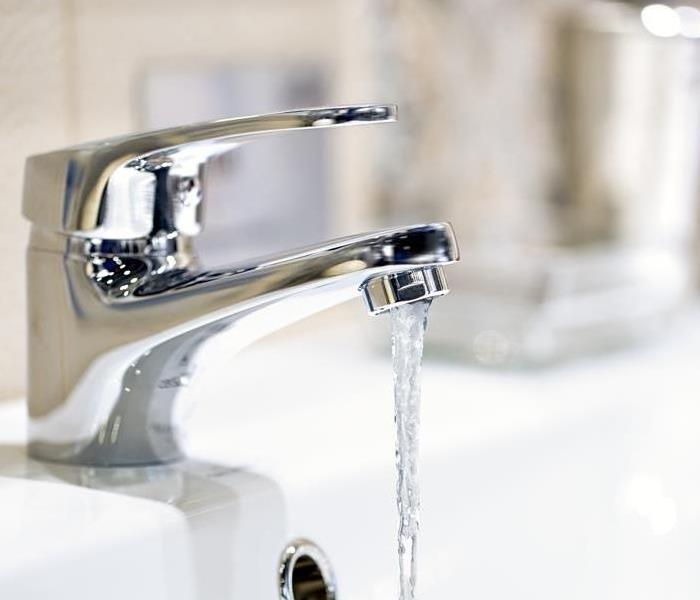 Preparing for a freeze can help prevent water damage to your home or business.
Preparing for a freeze can help prevent water damage to your home or business.
Frozen pipes are a common issue that homeowners face during cold weather months. When water freezes in your home's plumbing, it can cause serious damage to your property and lead to expensive repairs. If you're looking for ways to prevent frozen water pipe breakage from occurring in your home or business as winter breaks, read below!
Pipe breaks are serious
Water damage from frozen pipes is a serious issue and can happen to anyone. The cost of repairing the damage can be expensive, but there are some things you can do to prevent it.
If you live in an area where freezing temperatures are common, winterizing your home's plumbing system is essential for avoiding costly repairs or replacement later on. A little preparation now will save time and money down the road when those freezing temperatures arrive again next year!
How to tell if you have frozen pipes.
If you think your pipes are frozen, there are some things you can do to check. First, look at the outside of your pipes. If they're covered in ice, chances are good that they've been frozen and need attention.
Secondly, check to see if your water flow is smooth or slow--if it's flowing smoothly, then there isn't anything wrong with your pipes.
Prevent frozen water pipe breakage.
You can prevent frozen water pipe breakage by draining the pipes before freezing temperatures arrive. You can also insulate pipes in unheated areas of your home, such as attics and crawl spaces.
Drain faucets at least once a year to keep them from freezing during cold weather. Make sure all other drains are clear of debris as well, especially around fixtures like washing machines or dishwashers that may have drainage hoses attached to them.
Frost proof faucet
To prevent your outdoor faucet from freezing, install a frost-proof outdoor faucet. These special faucets have an internal valve that opens when the temperature drops below freezing, allowing water to drain from the pipe and preventing it from freezing. Frost-proof outdoor faucets are available at home improvement stores and can be installed by anyone with basic plumbing skills.
There are several ways that you can prevent frozen water pipe breakage from occurring in your home.
Frozen water pipe breaks can cause a serious issue for anyone. There are several ways that you can prevent frozen pipe breakage from occurring in your home, including draining the pipes before freezing temperatures arrive and installing a frost-proof outdoor faucet. If you have any questions about how to take care of frozen pipes or need professional assistance with this issue, contact us today!
How to Prepare for a Hurricane
2/12/2023 (Permalink)
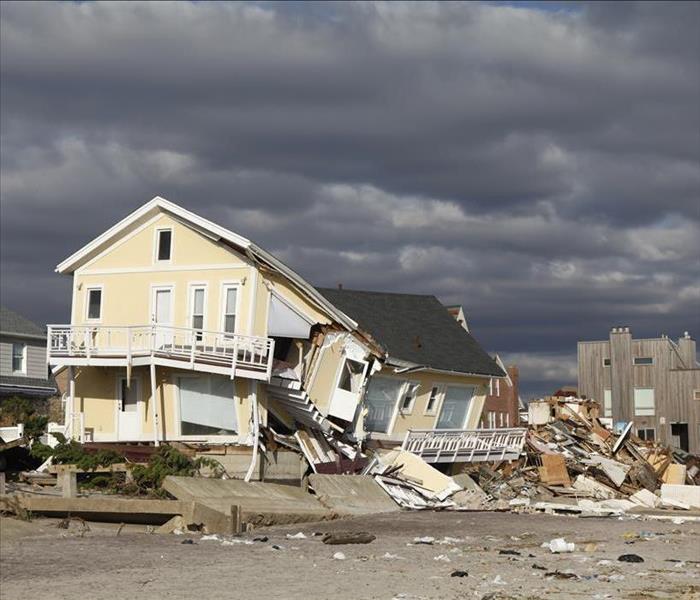 Louisiana has seen over 50 hurricanes since the 1930s. This is how you prepare your home and family for a hurricane.
Louisiana has seen over 50 hurricanes since the 1930s. This is how you prepare your home and family for a hurricane.
Hurricanes are very powerful, destructive storms that can bring high winds and heavy rainfall. Hurricanes form in the Atlantic Ocean, Caribbean Sea, or Gulf of Mexico and then move toward land. In the United States, hurricanes are most likely to hit Florida, Louisiana, and Texas. In fact, Louisiana has seen over 50 hurricanes since the 1930s. This is how you prepare your home and family for a hurricane.
What is the difference between a hurricane watch and a hurricane warning?
A hurricane watch means a hurricane is possible in the next 48 hours. In these cases, you should be prepared to either shelter in place or evacuate, but it is very possible that the storm will die down before it reaches you.
A warning means that a hurricane is expected in the next 24 hours. Hurricane warnings are issued by the National Weather Service and they signal that immediate action needs to be taken in order to protect yourself and your family.
Be prepared before the storm
To be prepared for a hurricane, you should:
- Keep a list of emergency phone numbers nearby.
- Have a plan for where to go if you have to evacuate.
- Have an evacuation kit ready to go with everything from food, water, and any medications.
Pack emergency supplies
One of the most important steps to take in preparation for a storm is to pack an emergency kit. You can store your emergency kit in a backpack or plastic storage bin, but be sure it's watertight and easy to carry if you need to evacuate.
Pack supplies for at least two weeks—and don't forget about pets! Keep enough food, water, and medicine on hand so that everyone in your household for at least 72 hours.
Remember to store your emergency kit in an easy-to-access location!
Know evacuation routes and have a plan for evacuation
Prepare for the need to evacuate the area. The best way to ensure that you can evacuate quickly is to know the route you'll take and how long it will take. If you are in a coastal area, have a plan for where you will go if the storm requires an evacuation.
Prepare your car
Most people's form of evacuation relies on their vehicles. Before the hurricane, it is important to prepare your car.
- Make sure you have a full tank of gas.
- Have a spare tire and jack.
- Have a cell phone charger in your car.
- Keep an emergency kit in your car.
- Move your car into a garage or under cover.
Prepare to shelter in place
In some cases, it might not be safer to shelter in place than it is to evacuate. Hurricanes are extremely dangerous for everyone, but especially for those who venture outdoors. If you need to shelter in place, remember to stay away from windows and doors and stay away from trees, power lines, and flood waters.
Prepare your home
To minimize the risks of damage to your home during a hurricane, there are several things you can do to prepare your home.
- Shut off utilities such as electricity, gas, and water.
- Remove trees limbs and other debris from your yard that could cause damage to your home.
- Make sure your home is secure and ready for flooding if necessary: cover windows and doors, place sandbags in front of entry points to your home, and make sure outdoor furniture has been moved somewhere safe.
The best way to keep your family and home safe from a hurricane is to be prepared. If you do not have an emergency plan in place already, it is important that you create one before the next hurricane unexpectedly hits. Remember, if your home or business suffers from damage due to a hurricane, our SERVPRO of Lafayette team can help with all the flood damage cleanup and restoration.
How To Inspect a Fireplace
12/7/2022 (Permalink)
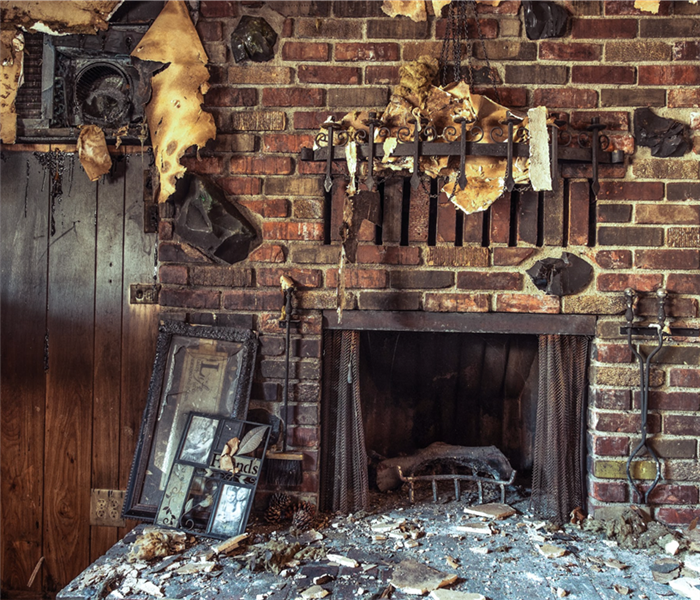 Schedule a chimney inspection with a professional.
Schedule a chimney inspection with a professional.
If you have a fireplace in your home, it is important to inspect it regularly. A chimney inspection will help you maintain the safety and effectiveness of your fireplace. Here’s how:
Inspect the Inside of Your Fireplace
First, inspect the hearth (the bottom surface where logs rest) and firebox (the area between them). If they're damaged or missing, they must be replaced before using your fireplace again.
Then, check for damage to stove pipe vents—they should not leak smoke from their joints when air pressure changes during operation.
Clean Out Ashes
It's important to remove ashes from your fireplace before they get too hot. To do so, you'll need to use a fireplace tool, which will help you scoop out any remaining ashes in the hearth.
If you don't have a fireplace tool, use a broom or dustpan instead. You should also check your chimney for blockages regularly (every two weeks) and remove them as needed: sticks, leaves, and other debris can get stuck in the flue and cause damage over time if left unchecked.
It's not recommended that vacuums be used on fireplaces because they can cause sparks which could lead to an accident with potentially serious consequences!
Check for Clearance Issues
Measure the distance between the fireplace wall and the floor. If there are less than 18 inches of clearance, you should consider moving your furniture or furnishings away from the fireplace to create more space. Then, measure the distance between the fireplace wall and any combustible materials such as curtains or hanging rugs that could catch fire if they come in contact with your flames. If there isn't at least 12 inches of clearance, move these objects away from where they might touch hot embers after you've burned a fire in your fireplace. You can also opt for safer alternatives—like vinyl window treatments—to help protect yourself against fires while still enjoying all of those beautiful natural light and heat benefits offered by a roaring fire!
Check for Creosote Buildup
Creosote is a by-product of combustion, so if you're properly burning your fireplace, it should be a rare sight. However, creosote can build up in the chimney over time and cause serious problems. If left unchecked, creosote can ignite and start a chimney fire; this is especially dangerous during the winter months when the temperature outside is below freezing.
If you think that there might be some buildup on the inside of your chimney (it's hard to tell without looking), take caution before lighting your next fire.
Creosote can also cause damage to other components of your fireplace system including flues and damper systems.
Check the Outside of Your Fireplace
Once you've inspected the inside of your fireplace, it's time to turn your attention to the outside. The first thing you should do is check for cracks in the mortar and bricks. If any are found, these need to be repaired before you can use your fireplace again.
Next, look at the flue and see if there are any cracks or holes that need attention.
Schedule a Chimney Inspection with a Professional
If you want to make sure your fireplace is working safely and efficiently, schedule a chimney inspection with a professional. Chimney sweeps are specially trained and experienced in the ins and outs of fireplaces, and they can be an invaluable resource when it comes to getting the most out of your fireplace. You should schedule an inspection every year if possible; if not possible due to lack of funds then at least once every five years would be ideal as well.
As you can see, chimney cleaning is an important part of fireplace maintenance. If you want your fireplace to stay safe and effective, it is important to regularly inspect it and schedule chimney cleanings.
If you want to keep your fireplace safe and functional, it is important to regularly inspect the outside of it. This will help you identify any issues before they become serious problems that require costly repairs and replacements. Give SERVPRO of Lafayette a call if you experience a fire in your Lafayette, LA home!
Water is Leaking Through My Light Fixture! What Should I Do?
11/15/2022 (Permalink)
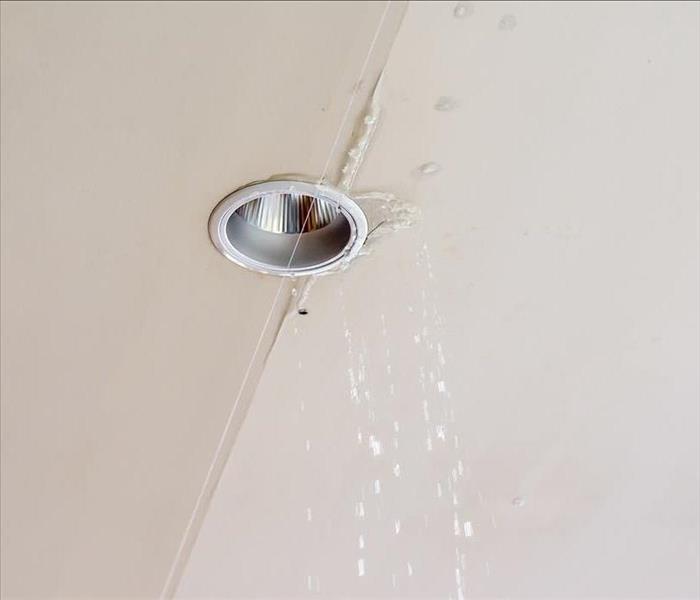 If your water is leaking through a light fixture, act quickly.
If your water is leaking through a light fixture, act quickly.
Why Water Is Leaking Through My Light Fixture?
Water leaking through a light fixture is a common problem in homes that have plumbing leaks, which can occur either under or behind the sink, around the bathtub, or anywhere where water can collect. When it happens, it's important to act quickly to prevent further damage. This article will help you understand why water is leaking through your light fixture and what you can do about it.
If your water is leaking through a light fixture, there are several things you should do immediately. This is a serious problem. Do not touch the light fixture or any electrical equipment in the area. Call an electrician right away to fix it for you. If you don’t know where to find an electrician, look online or ask friends and family members if they can recommend somebody. Do not try to fix this by yourself!
Turn Off the Water and Electricity
This should be obvious, but it's worth stating. Turning off the water will prevent further damage if you don't know where the leak is coming from yet. If you can't turn off your pipes or faucet, use a wet/dry vacuum to clean up as much water as possible before calling a professional for help.
Clean Up the Mess
If you have a wet/dry vacuum, use it to suck up any water that is on the floor. If this is impossible to do due to the leak being too big or your vacuum not being strong enough, then use a towel or other absorbent material (like an old t-shirt) and soak up as much water as possible.
Monitor the Situation
To monitor the situation, you'll need to keep an eye on the room temperature and humidity levels. If they rise above normal levels and/or you notice a musty odor, it's possible that mold has begun to grow in your home. If this happens, call a specialist right away! It's important not to wait until the damage is too severe before seeking out help—a professional can help you fix any problems before they become too severe.
Respond Quickly
Water damage in your home can be a big problem, but it's important to respond quickly. You should never ignore water leaks, as they can cause serious problems if left unattended for a long time. The longer the water sits, the more damage it does.
If you notice any water leaking in your house or building, there are several steps you can take to make sure that this doesn’t cause long-term damage:
Turn off the source of the leak ASAP: Whether it’s a burst pipe or faulty shower head, turn off whatever is causing the leak immediately by shutting off its valve under sink or behind toilet tank.
Check for signs of mold growth: Mold spores need warmth and moisture to grow so if you see soggy drywall or other materials that were once dry becoming damp and moldy (moldy), then there's probably been some sort of water intrusion somewhere in that area recently - usually through porous materials like wood paneling or carpeting which absorb liquid instead of repelling it outward like rubberized coatings do on bathroom walls!
We hope that this article has helped you figure out what to do if water is leaking through your light fixture. If you’re concerned about water damage in your home, it’s important to respond quickly. That way, you can avoid issues like mold growth and costly repairs!
When you have a water leak in your home, SERVPRO of Lafayette is here to help you get your Baton Rouge, LA home back to normal!
Do I Need Fire Insurance For My Building?
10/16/2022 (Permalink)
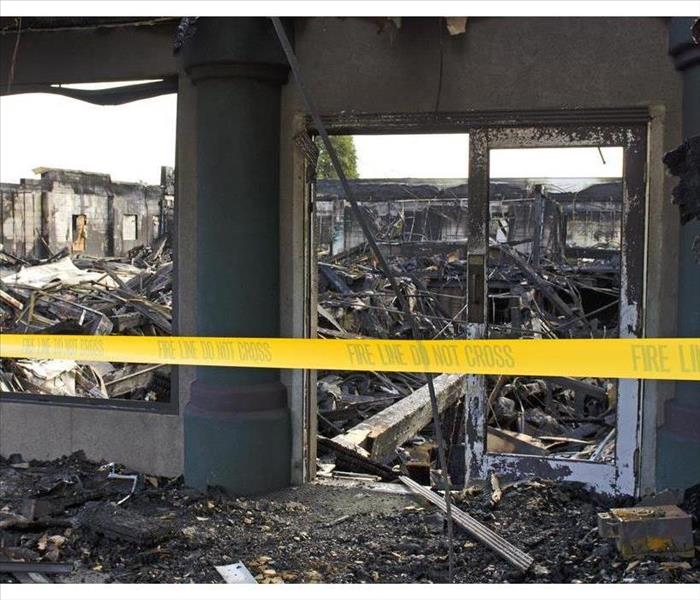 If your business is located in an area with high fire risk, you should consider purchasing fire insurance.
If your business is located in an area with high fire risk, you should consider purchasing fire insurance.
Protecting Your Business Against Fires
You may not think about fire insurance, but it's important for your business. Fires can cause significant damage to a building and pose a risk to the safety of your employees and customers. While you have many options when it comes to protecting your business against fires, one of the most basic choices is whether or not you should get fire insurance coverage. The answer depends on several factors including how old your building is, where it's located and what kind of business you operate. In this article, we'll look at some common questions about fire insurance so that you can make an informed decision about whether or not this type of coverage makes sense for your situation.
Fires Destroy More Than Just Things
Fires can be devastating. Not only do they destroy valuables, but they also have the power to consume or destroy all a business's hard work and investment. If your business is located in an area with high fire risk, you should consider purchasing fire insurance.
The cost of rebuilding is one important factor to consider when deciding whether or not to purchase fire insurance. The amount of money it will take to rebuild your building depends on many factors including what type of structure you had before, how much damage there was during the fire, and whether or not there were any injuries sustained as a result of said fire.
Sometimes Fire Insurance is Required
Fire insurance is not required by law, but it's a good idea for many businesses. If your business is financing its building or leasing it to tenants, the bank might require fire insurance as a condition of its loan.
Fire Insurance Coverage
Fire insurance can help protect your business from the financial impact of both property and business interruption losses. Property insurance will cover the value of goods damaged or destroyed in a fire, and business interruption insurance will pay for lost income if you are forced to close down temporarily due to a catastrophic event such as a fire. Both types of coverage can be purchased separately or together, depending on your needs and budget.
In addition to protecting your building and its contents, fire insurance can also cover computer equipment that may be damaged by smoke inhalation or water seepage into electrical equipment during an emergency response effort by firefighters.
Fire insurance can help protect your investment and save money in the event of an unexpected fire in the future. It’s a good idea for any business, but it is especially important for businesses that have inventory or equipment. A fire can be devastating to these types of businesses and significantly impact their ability to operate. If you suffer damage from a fire, your insurance policy will pay for repairs or replacement costs up to the limits listed on your policy.
Fire insurance is a great way to protect your business and investment, even while you are away from your building. There are many other types of insurance and property policies that can help protect against fire, so it's important to talk with an insurance agent before deciding on which policy works best.
When your Baton Rouge business catches on fire, Give SERVPRO of Lafayette a call!
4 Easy Steps To Operate a Fire Extinguisher
8/29/2022 (Permalink)
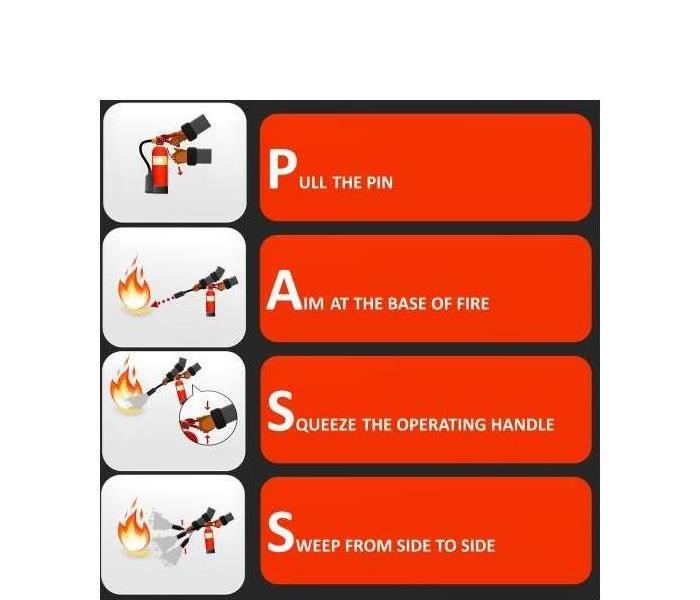 P.A.S.S Technique
P.A.S.S Technique
Proper Operation Techniques Can Be Learned In Just A Few Moments
Fires spring up suddenly in homes every day. A couple of inexpensive and easy-to-use tools can protect your family from the damaging effects of fire and reduce the damage to your property. Fire alarms should be installed throughout your home in Lafayette, LA, and they should be tested a couple of times a year to ensure they are working properly. A fire extinguisher or two should also be in every home. Just as importantly, every person in the home 10 years or older should know how to use the device.
1. Pull the pin - Nearly every fire extinguisher will be equipped with a pin or tamper seal to make certain the device does not prematurely discharge. The first order of business is to pull the pin or break the tamper seal.
2. Aim the extinguisher - You do not want to aim the device at the top of the flames. Rather you want to aim low at the fire's base. This will be the most effective way to put the fire out quickly and limit fire damage to your home. Some models have a hose while others have a short nozzle.
3. Squeeze the trigger - Now you are ready to discharge the contents of the extinguisher. Just squeeze the handle and the extinguishing agents will come rushing out.
4. Sweep the area - While the contents are being discharged, be sure to sweep across the base of the fire, moving from side to side. This is the most effective motion whether you are dealing with a kitchen fire or another type of blaze.
Learning how to properly use a fire extinguisher strengthens your household's response to a fire. Developing a relationship with a fire mitigation team in your area is also a good idea. This allows you to call for restoration help if you do experience a fire in your home.
3 Steps for Cleaning Dryer Lint
8/20/2022 (Permalink)
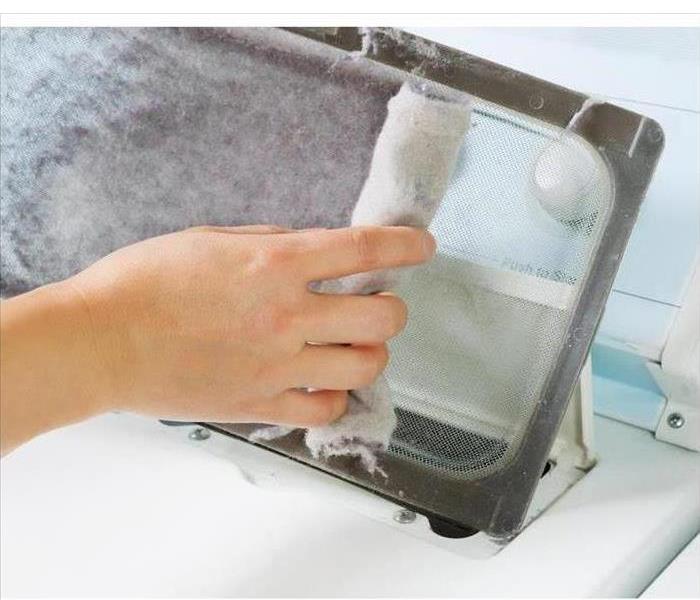 Clean the lint screen of your dryer
Clean the lint screen of your dryer
Three Steps To Avoid Calling a Fire Restoration Company
Did you know that your clothes dryer can be a cause of a home lint fire? According to the United States Fire Administration, there are about 2,900 clothes dryer fires reported each year. The USFA also states that almost 35% of those fires could have been prevented if the dryer had been cleaned. Ensure that your Lafayette, LA, home doesn’t suffer the devastating effects of fire damage by cleaning your dryer regularly. Here are three steps to follow to avoid needing to call a fire restoration company.
1. Clean the Screen
The first part to clean is the lint screen. Every clothes dryer has a lint screen located on top or inside the bottom of the door. There are three ways to remove lint from the screen:
- Run your fingers gently across the screen
- Wipe a used dryer sheet on the screen
- Use a vacuum brush attachment
It’s important to clean the lint screen before each new load to prevent a lint fire. If you use dryer sheets, remove the screen every month and run it under water to remove any residue.
2. Deep Clean the Vents
In addition to cleaning the screen, it’s necessary to deep-clean the vents at least once a year. Lint can get trapped and accumulate inside the vent, which leads to inefficient drying and possible combustion. Fortunately, cleaning the vent isn’t difficult.
First, unplug the dryer and shut off the power to the machine. Next, move the dryer away from the wall and remove the hose. Third, gently wipe the interior or put a vacuum attachment inside to pull out the lint. Finally, use a dryer cleaning kit and follow the instructions to clean the wall vent.
3. Clean the Exterior and Interior
Cleaning the outside and inside of the appliance prevents a dryer fire. Remove the back panel of your dryer with a screwdriver and gently wipe all areas with a soft cloth. Check inside as well to remove any lint in the drum.
Removing lint from the screen before each load and thoroughly cleaning the vents and dryer can prevent a lint fire.
How to Clean a Moldy Shower
8/15/2022 (Permalink)
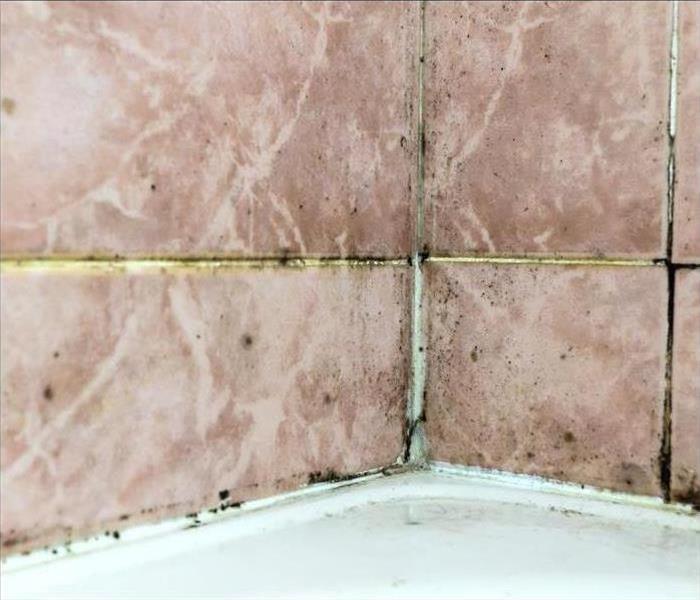 Mold growth on shower
Mold growth on shower
Residential bathrooms are one of the most common places to find mold. The warm, wet, humid environment creates a perfect fungal breeding ground. Shower mold is especially common due to the excessive moisture that tends to get left behind. Follow the steps below if your shower in Lafayette, LA, is affected by unwanted mold growth.
Cleaning Shower Mold
Black mold is a common occurrence for many showers, so there are plenty of tried and true cleaning methods available. Here's one of the most effective techniques:
- Create a safe, non-toxic mold cleaning solution using equal parts water and white vinegar. Pour this mixture into a clean spray bottle.
- Mist down the moldy areas with the cleaning solution. Create a generous, even layer, but make sure you don't oversaturate the area. If puddles are forming in the shower basin, you're using too much solution. Let sit for 5-10 minutes.
- Use a clean cloth to wipe down the solution. The mold should easily come off with it. You may need to use multiple cleaning rags, depending on how large the affected area is.
- If some mold still remains, use a kitchen sponge or scrub brush to scrub it off. Mold growing in the shower grout or caulking can be removed using a spare toothbrush.
Completely dry the area using a clean rag or cloth. Make sure you remove all of the excess moisture to prevent further mold growth.
Preventing Bathroom Mold
Keeping your bathroom clean and dry is the best way to prevent mold growth. Prevent condensation from building up by opening a window or cracking the bathroom door open next time you shower. After each shower, make sure you wipe down the shower tiles and tub edge (when applicable). Mop up any puddles that are left on the floor. Spread the shower curtain out to help aid in the drying process.
Shower mold is extremely common, but it's also relatively easy to remedy using the above technique. If you find that your mold situation has spread out of your control, or the method above isn't working for you, you need to contact mold remediation experts immediately.
Ways To Save Water in Your Commercial Building
7/30/2022 (Permalink)
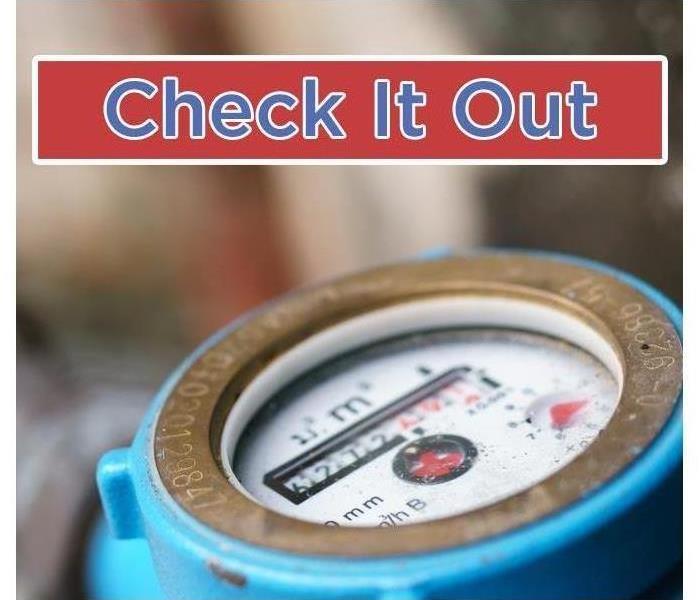 Monitoring your water meter is the best way to catch a troublesome area.
Monitoring your water meter is the best way to catch a troublesome area.
Methods for Conserving Water in Commercial Buildings
Owning a commercial property comes with a lot of expenses, and many of them aren't completely under your control. Unless everyone who works in your building in Lafayette, LA is committed to water conservation, your utility bill may be higher than you expect. You can still take some steps, however, to address water issues and reduce the overall amount used.
Energy Efficient Appliances
Start by simply choosing appliances that require less water usage. Check the energy rating on several appliances in your break room and throughout the building:
- Refrigerator
- Dishwasher
- Water fountain
When you look for ways to reduce consumption at the source, you can lower your usage overall.
Touch-Free Upgrades
The public restroom is probably your number one culprit for water waste. You may have lost count of the number of times you have walked in to discover that a faucet has been left on or a toilet is still running. The cost of touch-free options or another water upgrade may seem daunting at first, but they are likely to pay for themselves within months by helping you overcome the water issues that lead to high utility bills.
Meter Monitoring
You should always know how much water you are using in your building. Monitoring your water meter is the best way to catch a troublesome area. It's also a good idea to keep your outside irrigation and your internal water usage on separate meters so that you can more easily identify where the waste is coming from.
Quick Mitigation
If you discover that your meter is running higher than usual, this could be an indication that you have a leak somewhere. Call your plumber to fix the problem and contact water damage specialists to mitigate any issues caused by the leak.
Keeping track of your building's water issues is only one way to lower your utility bill. By employing multiple strategies, you can reduce your water usage and cost.
How To Effectively Take Care of a Basement Flood
7/20/2022 (Permalink)
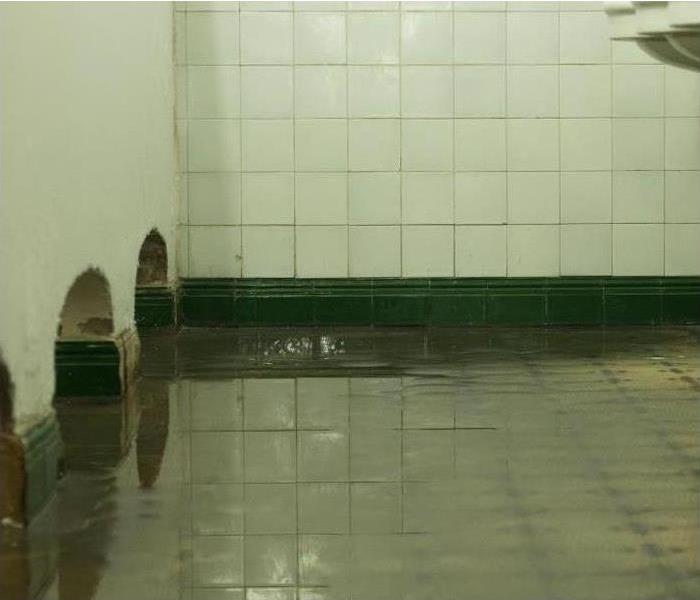 By following these steps, you can clean up after a basement flood.
By following these steps, you can clean up after a basement flood.
How to Handle a Basement Flood Effectively
Of all the places in your home, the basement may be the most common spot for water problems. Many people in Lafayette, LA, have dealt with a basement flood. Your location, poor drainage or plumbing problems could lead to flooding here. Make sure you know what to do if you face this challenge. The right response can spare you a lot of stress and grief.
Your First Steps
When you first discover a basement flood, assess the situation, and make sure everyone in your home is safe. If the water is threatening anyone's safety, evacuate the house and call 911. You should then do the following:
- Find the source of the flood and stop it if you can safely do so.
- Remove materials from the area and get them to higher ground.
- Unplug electronics or turn off the power to your home.
Start Removing the Water
A flooded basement can come in all sizes. If the water covers a small area, you can grab a wet vacuum and extract the water yourself. You should also get some air moving by placing fans in the area.
Call the Pros
If the water is spreading throughout the basement and damaging materials, get in touch with a professional flood cleanup company. Professional technicians can get to your home within a few hours of your call. The crews will use industrial-grade machines to pump out and remove all the water from the basement. The team will then dry and disinfect the area to make sure there is no mildew or mold growth.
File a Claim
Insurance coverage is essential when it comes to cleaning up after a flood. Your policy should be effective if there was a sudden, unexpected pipe burst or appliance leak. Give details to your agent about what has happened. Provide pictures of the damage.
By following these steps, you can clean up after a basement flood. A professional company can help make this process faster and more thorough.
Landlord Responsibilities After a Commercial Apartment Fire
7/13/2022 (Permalink)
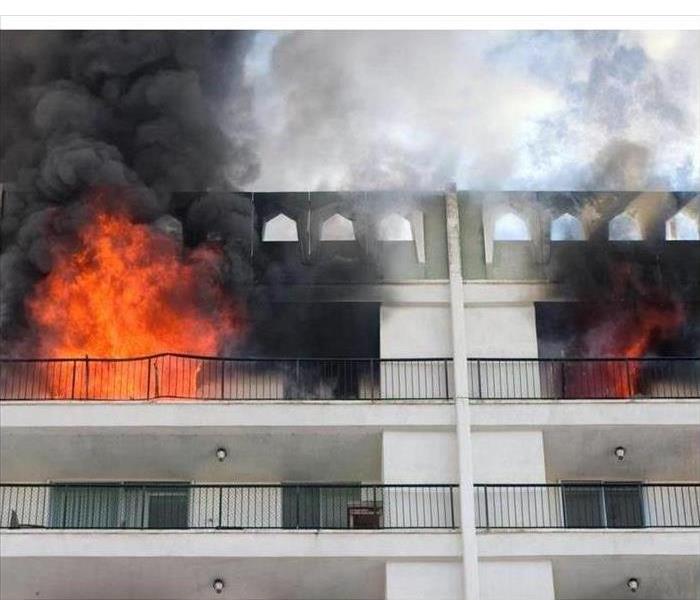 An apartment fire in Lafayette, LA
An apartment fire in Lafayette, LA
What To Do After A Commercial Apartment Fire
A commercial apartment fire in Lafayette, LA, affects both you and your tenants. You may be in shock and wondering exactly what to do next. You also need to determine the damages for which you are responsible.
First Steps
Once you find out about a fire on your commercial property, you need to take immediate action. Your first steps should include:
- Reporting the fire to your insurance provider
- Setting up appointments with restoration companies
- Talking to your tenants about the cause of the fire
- Asking the fire officer when it is safe to enter the premises to survey the damage
In the days after the blaze, take pictures of the property and create an inventory of any structural damage. You should also cover openings and lock doors to keep out looters.
Landlord and Tenant Responsibilities
Next, you must determine which of the apartment fire repairs are your responsibility. In general, the landlord is in charge of fixing fire damage to the property itself, including the plumbing and electrical systems. Your insurance policy should help you cover the cost of these emergency restoration services.
The tenants, meanwhile, must repair or replace any items that they purchased for the commercial apartment. However, things get a bit complicated if the fire resulted from negligence by the landlord or tenants. If the tenants can prove that you were responsible for the blaze, they may be able to recoup additional money from you.
Similarly, you may not have to pay for all of the apartment repairs if it is determined that the fire was the fault of a tenant. In this scenario, your insurance company may work with the tenant or the tenant's insurance company to get compensation. You also may want to put in your lease specific language about landlord and tenant responsibilities following a fire.
Make sure that you and your tenants each understand what they need to do after a commercial apartment fire. This will expedite the restoration process.
Your Dryer Could Be a Fire Hazard
6/26/2022 (Permalink)
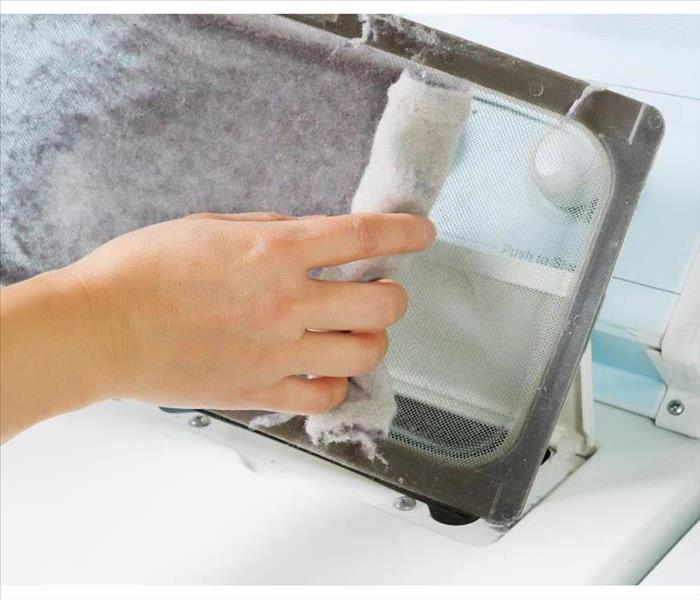 Improper cleaning of your dryer machine can cause lint fire.
Improper cleaning of your dryer machine can cause lint fire.
As a homeowner in Lafayette, LA, you frequently rely on your home dryer. Did you know that improper cleaning and use of the machines can cause lint fire. Although useful, residents must understand how to maintain their units and mitigate potential trouble. The following are statistics about potential dryer blazes and what owners should do to safeguard their homes.
How Often Does a Dryer Fire Occur?
Yes, you use the dryer often and don't have a problem. However, the potential for flames is higher than you may believe. The National Fire Protection Agency notes that most home fires result from lint, dust and fiber, with approximately 92% of household fires involving the clothes dryer. In addition, the United States Fire Administration reports the following statistics.
Approximately 2,900 dryer fires get reported annually
Property loss claims amount to as much as $35 million a year
27.6 of dryer units ignited because of lint or material buildup
How Do the Fires Start?
Dryer fires often start because the machines develop a buildup. When clothes tumble around, they shed lint. These flammable fibers are released from your blankets, shirts and pants during the dryer's run, accumulating on trap and exit tubes. When this fluff overheats, a lint fire begins.
How Can You Minimize This Impending Threat?
Take care to install your machine correctly and have it regularly serviced, ensuring it's in proper working order. In addition, establish a routine system for clearing lines from the dryer components. Empty the trap after each cycle. Then, check the area behind the dryer at least once a month. Have a service crew fix any signs of damage immediately. Hire professionals to clean it at least once a year.
Enjoy your dry clothes and understand the importance of avoiding a lint fire. If flames occur, leave home and call for help. Have an expert fire remediation team inspect, sanitize and repair the room.
3 Ways To Prepare Your Home for a Storm
6/18/2022 (Permalink)
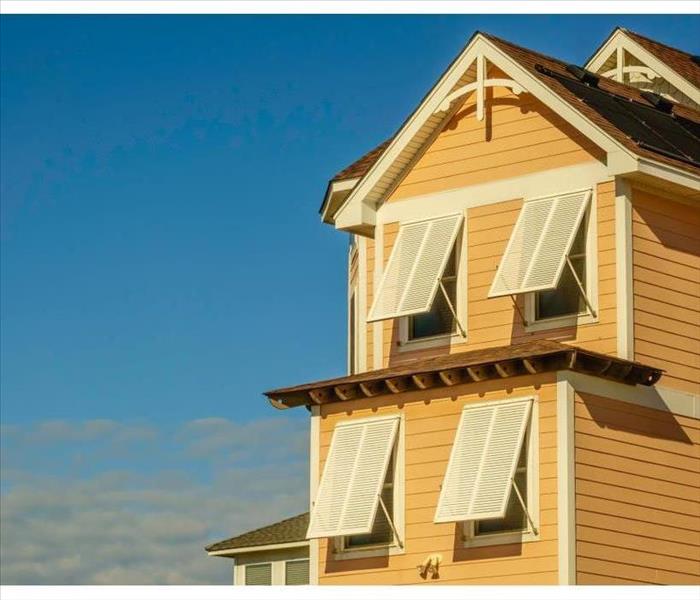 By installing shutters you prevent your windows from getting broken and letting the weather inside.
By installing shutters you prevent your windows from getting broken and letting the weather inside.
Three Steps to Storm-Proofing Your House
Whether it's a blizzard in the middle of winter or a mid to late summer hurricane, you never want to be caught unaware. When you leave your home unprotected, you leave your family's safety up to chance. Here are three ways to prepare your home for a storm and keep your family safe.
1. Clean Landscaping
Even small branches can become projectiles in a powerful storm. To best protect your home, remove all dead or dying tree limbs. Cut back any trees that hang over your home or any power lines. If a limb were to break off during a storm, it could do considerable damage to your home and cause you to lose power.
Additionally, ensure that your gutters and storm drains are clean and free from debris. A blocked storm drain could mean that your Lafayette, LA, home could quickly become overrun with flood water and turn into a flooded building.
2. Install Shutters
If even one of your windows breaks in a storm, you could find yourself in trouble. Install sturdy shutters on all of your windows to prevent them from getting broken and letting the weather inside. Steady rain coming through a broken window could cause a tremendous amount of water damage in a short period. Furthermore, if the flood water is high enough, a broken window will let the water into the house. If a flood makes its way inside, you'll need to call storm damage repair specialists to handle the clean-up.
3. Stop Flood Water From Entering
Before a big storm hits, evaluate your home and identify potential risks. Install a sump pump to control the water if you have a frequently flooded crawl space. If you have cracks or breaks in your foundation, contact a specialist to have them repaired. It can also be helpful to grade your lawn away from your home, so the floods have a more difficult time reaching the house.
Storms can be stressful, but taking the time to protect your home before one hits can help take a weight off your shoulders.
Know the Different Types of Water Damage
6/3/2022 (Permalink)
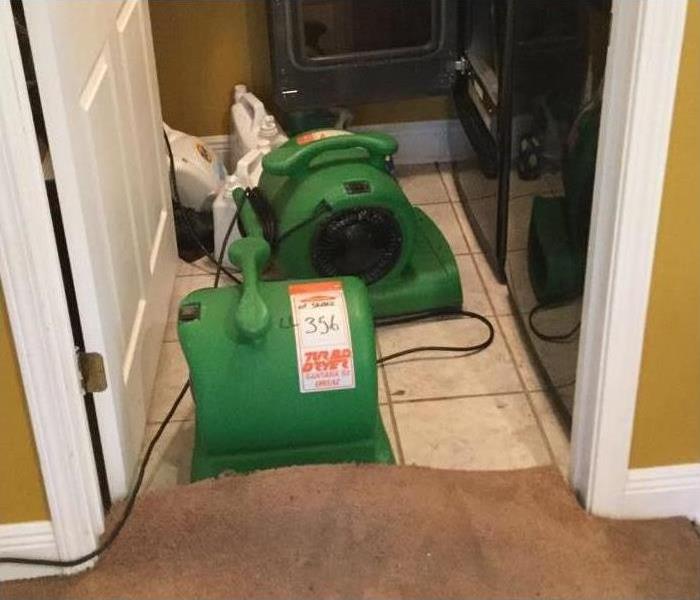 Laundry room washer leak.
Laundry room washer leak.
Whether heavy rains or a leaking pipe, water damage to your Lafayette, LA, home requires swift action. The longer it sits, the more potential there is for additional damage, such as mold growth. At the first signs of water is easy to want to grab whatever is on hand to start the cleanup. Before doing that is vital to understand the type of water you are dealing with.
Flood Damage Categories
There are three categories of water damage, all of which come from different sources.
Category 1: Considered clean water, the source could be a burst pipe or sink overflowing. This water has no contaminants, making it safe for people to handle.
Category 2: Referred to as gray water, it often has chemicals, biological contaminants, or microorganisms. Sources for sustaining this damage include dishwasher overflow, water from condensation, or sump pump failure.
Category 3: This is the dreaded black water that comes from flooding and often has sewage, toxins, chemicals, and other substances that are best left untouched. Along with sewage backups, floodwaters, and rising groundwater, gray water not properly taken care of may become this type of damage.
Proper Restoration
Any water left unchecked has the potential to cause more issues, even clean water. When it is classified as the other two categories, calling a professional storm damage restoration company is often the best choice. Dealing with contaminated water requires assessing the extent of the damage, developing a plan of action, and then cleaning and repairing the damage using industrial-grade equipment and professional methods.
While any type of water damage your home sustains is a negative situation, the type of water causing the issue should also be a top concern. Verifying the source of the intrusion helps ensure the right measures are taken for proper cleanup.
6 Ways To Maintain Your Sump Pump
5/30/2022 (Permalink)
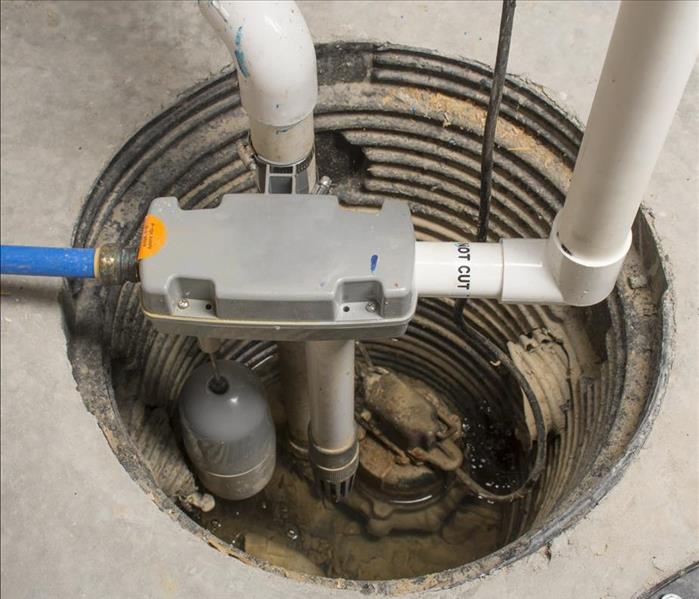 Make a point to check your sump pump often.
Make a point to check your sump pump often.
Sump Pump Maintenance
Your sump pump is something you probably don't think about often. However, you will surely remember this essential piece of equipment if a bunch of water invades your Lafayette, LA, home's lowest floor. It's vital to frequently maintain your pump to ensure it's there when you need it most.
1. Inspect the Drain Pipes for Blockages
Your drain lines must remain clear for the pump to work to its fullest potential. Check them regularly by pouring hot water down the pipe from upstairs. The water will flow fast down the line into your sewer or lawn if it is clear.
2. Look for Leaking Oil
Discovering oil on the pump can be a sign of an oil leak. A leak would mean repairing, or possibly even replacing, the pump.
3. Check for Leaks in the Basin
You also need to check the basin to check for leaks or cracks. A leaky basin can result in damage necessitating work by water damage restoration experts. Look for potential leaks by removing everything from the pit and filling it with water.
4. Test the Sump Pump Alarm and Battery Regularly
The alarm is essential, as it notifies you of issues. Ensure that you can hear it from any area of your home. In addition to testing the alarm, test the backup battery. Unplug the pump from its power outlet and fill the basin with water. The backup battery is working correctly if the pump starts instantly.
5. Test the Electrical Components for Damage
Sump pumps use a significant amount of electricity, which can sometimes trip a circuit breaker. Avoid electrical problems by inspecting the power cord and outlet to ensure they are undamaged.
6. Check the Check Valve for Issues
The check valve is one of the most essential parts to inspect during pump maintenance. It is a component that commonly fails.
Make a point to check your sump pump often. This preventative action could mean the difference between incurring extensive water damage during a flood and no loss.
3 Steps To Prepare To Use a Fire Extinguisher
5/25/2022 (Permalink)
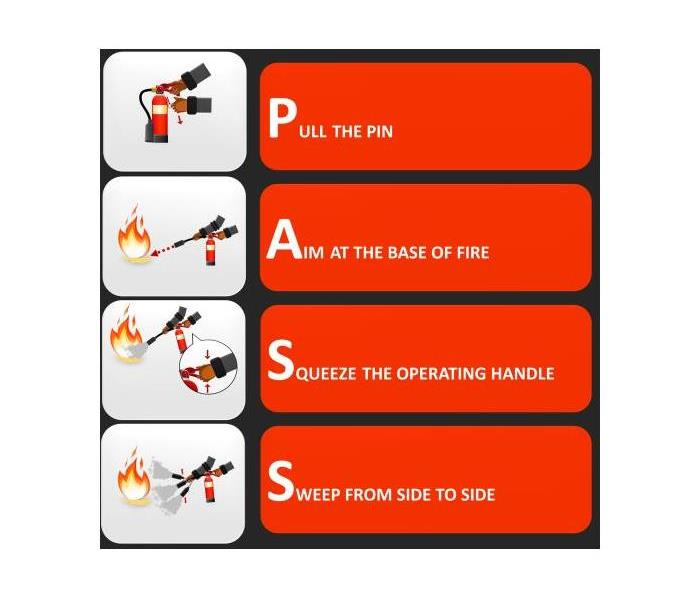 The acronym PASS stands for Pull, Aim, Squeeze and Sweep.
The acronym PASS stands for Pull, Aim, Squeeze and Sweep.
Three Steps To Prepare To Use a Fire Extinguisher
Extinguishers for fire are essential safety equipment, but many people are not sure how to use these tools when the flames are rising. Here are three steps that an employee delegated fire safety responsibilities or a manager of a commercial property can take to prepare to effectively use a fire extinguisher at a building in Lafayette, LA.
1. Check the Class of Extinguisher
There are five main extinguisher classes: A, B, C, D and K. Class A extinguishers are best for combustible solid materials. Class B extinguishers are formulated for flammable liquids and gasses. Use Class C extinguishers for electrical fires, Class D extinguishers for metallic fires and Class K extinguishers for cooking fires.
2. Check the Fire Extinguisher Date
An extinguisher must be functional in order to limit the need for fire damage restoration. Check the label or cylinder body of the canister for a date. The plastic ring or boot of an extinguisher can cover the date. Based on the date, it may be necessary to refill or replace the extinguisher.
3. Memorize the PASS Method
The acronym PASS stands for Pull, Aim, Squeeze and Sweep. Suppress a fire by pulling the extinguisher pin, aiming the nozzle at the base of the fire, squeezing the lever and sweeping the fire suppressant spray from side to side. The spray from an extinguisher can spread a kitchen fire involving grease. Smother a grease fire with a heat-resistant pot lid or powder suppressants such as baking soda and salt.
You should always use a fire extinguisher as intended. Set yourself up for success beforehand by checking to make sure that the fire suppressants in an extinguisher are rated for efficacy at putting out the substances that are most likely to ignite in each area of a commercial building in Lafayette, LA.
3 Common Causes for a Shower Leak
5/20/2022 (Permalink)
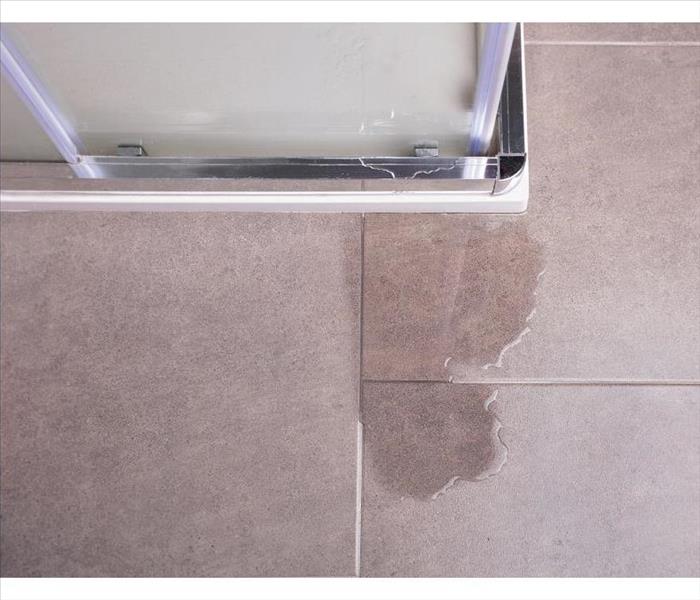 Shower pans can become damaged or worn and start to leak.
Shower pans can become damaged or worn and start to leak.
Reasons Your Shower Could Be Leaking
If you regularly see standing water after a bath or shower, you'll want to address the situation immediately to ensure you don't have a bathtub leak in your Lafayette, LA, home. Here are three reasons your shower could be leaking.
1. Broken Tiles or Missing Grout
Even a tiny crack in the tile or grout of your shower can cause a sizable bathtub leak. The water from the shower seeps through the crack and can damage the sheetrock and wood behind the wall. Look closely at each tile, and the surrounding grout, in the shower and look for cracks or missing pieces. If you don't feel that you can replace or repair the damaged tiles yourself, contact a water damage restoration service to fix them and have them address any potential water damage from the leak.
2. Shower Pan Leak
Over time, shower pans can become damaged or worn and start to leak. To check for a leak, cover and plug the drain to ensure no water can get down it. Then, fill the shower pan with a couple of inches of water. If the bathroom is on the second floor, keep an eye on the ceiling underneath the bathroom. However, if the bathroom is on the main floor, look at the joists under the house. If there is a leak in your shower pan, you'll start to see water spots appear in as little as 20 minutes.
3. Damaged Caulking or Gaskets
One culprit that often causes a shower or bathtub leak is damaged caulking or missing gaskets. If you have a door on your tub or shower, turn on the shower and aim the water at the door. Look for any areas where water is obviously leaking out. Replace any missing caulking or gaskets to ensure the water stays inside the shower where it belongs.
Shower leaks can be stressful. However, knowing what to look for and relying on professionals can make a hard time lot easier to handle.
3 Essential Tips To Protect Your Business From Storm Damage
4/23/2022 (Permalink)
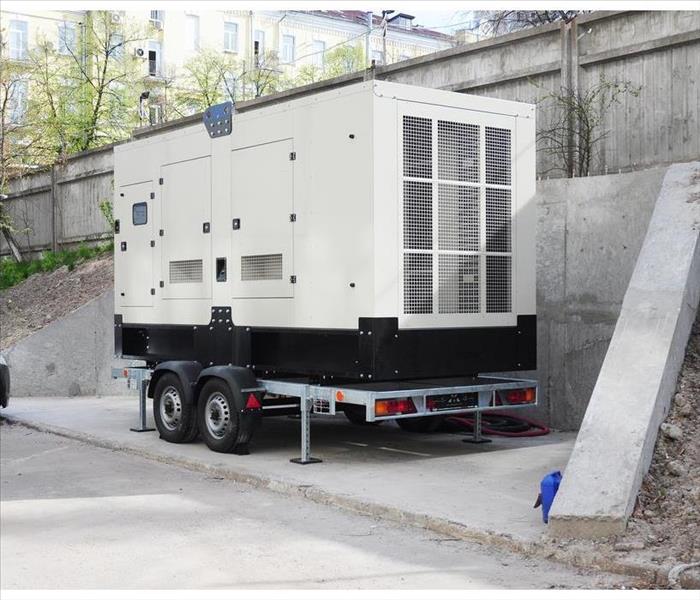 Invest in a generator.
Invest in a generator.
Be Ready When Disaster Strikes
A torrential rainstorm can have major negative impacts on your business if you're not prepared. Damaging high winds, floodwaters and long-term power outages can all result in extra expenses you may not have budgeted for. Thinking ahead can help you be ready when disaster strikes. Here are three tips to help you protect your business.
1. Invest in a Generator
If a thunderstorm in Lafayette, LA, knocks out your power, a generator can help you keep your business running, or at least prevent the loss of perishable items. You'll also be able to better protect your employees by keeping lights on and heat pumping if needed. Having power helps you maintain your ability to communicate with customers and staff so you experience fewer service interruptions and can keep everyone informed of your plans.
2. Communicate With Staff
Before a rainstorm rolls in, be sure to discuss your plans and expectations with your staff. They should know what to do in the event that you lose power or major damage is done to the building. Discuss what they should do if customers are in the building to keep everyone safe. Determine appropriate exit routes and where people should take shelter if the need arises.
3. Maintain Your Building
Proper building and landscape maintenance are key to keeping your business safe in a storm. Be sure to keep branches trimmed and away from windows. Perform regular safety checks on your building's perimeter and don't wait to fix any issues you discover. Investing in building safety can pay off in the long run when you don't have to deal with major damages once the storm has passed. If you do experience harm to your building, be sure to reach out for professional commercial building restoration services.
When a rainstorm rolls in, you want to make sure your employees and your assets remain safe. Follow these tips to help you be prepared in the event that Mother Nature upsets your bottom line.
Mold: Fascinating Facts
4/18/2022 (Permalink)
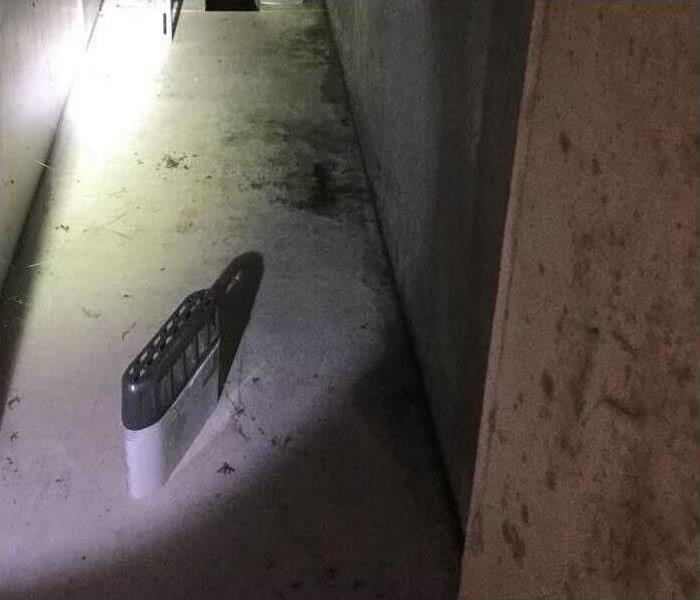 Small moisture problems become big mold problems.
Small moisture problems become big mold problems.
Mold Information
When studied from afar, mold, a type of fungus, is a fascinating organism. When experienced up close in your place of business in Lafayette, LA, black mold and other varieties are more disturbing than anything else. To start with the interesting facets of mold, it is found just about everywhere. It can even be found in desert climates. More than likely, it is in your building at all times without causing any problems. It needs water to grow and proliferate into bothersome colonies. A moisture source such as high humidity in a room, a steady water leak or standing water is often enough to foster a fungal outbreak.
Mold Damage
Another interesting trait of black mold is that it forms roots and penetrates into porous materials. A mold outbreak brings a number of unpleasant consequences:
- An ugly, slimy appearance
- Musty odors
- Poor indoor air quality
- Extensive damage to a property
Mold can break down wood and paper materials as well as penetrate into furniture, clothing and carpeting. A mold cleanup is needed when the colonies are causing any of these negative problems. Allowing the mold to grow unchecked will result in the spread of mold throughout your building. This will significantly complicate the restoration of your property.
Mold Remediation
The removal of mold from a property cannot be done with regular cleaning methods. Special techniques and equipment are needed as well as the expertise of an experienced mold mitigation company. A SERVPRO franchise is always Here to Help. Certified technicians will use thermal imaging to locate a water source in your building. These highly-trained workers will employ containment barriers to stop the spread, and they will use vacuums to suck up mold spores killed by effective fungicides. A professional cleaning will ensure that the mold won't return again. Whether your building has black mold or another variety of mold, a proven process will rid your property of this fascinating but harmful organism.
Top Alternatives to Using Sandbags
4/5/2022 (Permalink)
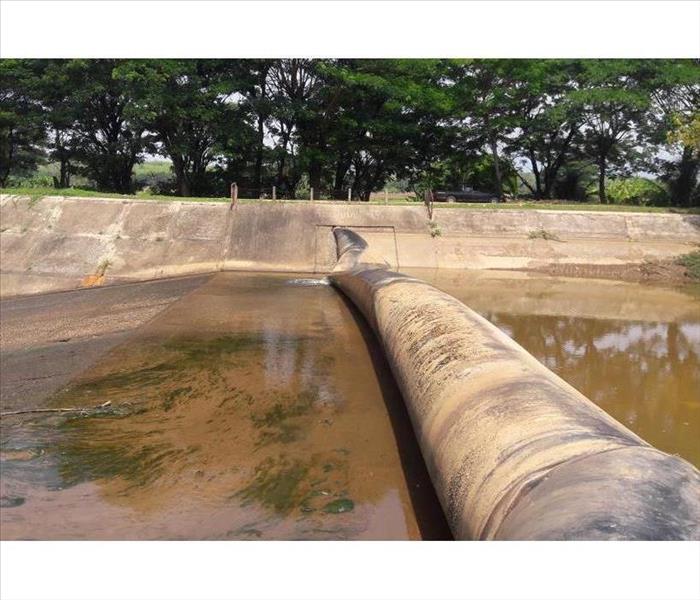 Inflatable flood dams are interesting because they use water to prevent flooding.
Inflatable flood dams are interesting because they use water to prevent flooding.
When you expect a flood in Lafayette, LA, you might automatically think of using a sand bag to stop floodwaters from creeping into your business. This might not be your best solution, but there are plenty of alternatives.
Why Seek an Alternative?
Sandbags have many issues when it comes to preventing water from creeping in and the need for water damage remediation. Some of these issues are:
- Weight
- Difficulty storing
- May become environmental hazards
When you use them for flood prevention, storage, setup and disposal are all cumbersome. They also are not the best way to prevent flood damage.
Transportable Flood Fence
These barriers keep the water out by encircling whatever you need to be protected. You can encircle your entire business if you need to. They are harder to prepare than the more traditional sand bag. Unfortunately, this solution is not practical if you have a small area like a doorway or your business is part of a strip complex. They also can be fairly costly.
Poly Tube Flood Barriers
These work on a similar concept as sandbags do. They consist of a long tube that can be filled with any heavy substance, including sand. You then stretch the tube across something as small as a doorway or as large as a bay door. This is a type of dam that can be lengthened or shortened to suit your needs. You just fill it as high as you need it and then put it into place. The only problem comes in when it is at full length. It can be difficult to move on your own.
Inflatable Dams
Inflatable flood dams are interesting because they use water to prevent flooding. You lay it out and fill it up. Unfortunately, this type can be cost-prohibitive if you are trying to cover a large area. Still, if you have a large area that floods frequently, it might just be worth it.
Consider these solutions to protect yourself. You don't need the hassle of filling a sandbag to prevent floodwaters from entering your business.
Cleaning Up Your Company After a Fire
3/29/2022 (Permalink)
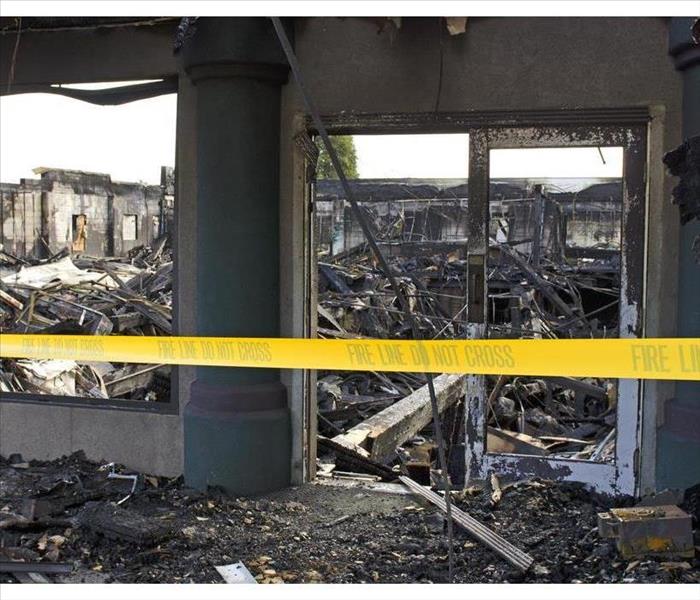 Commercial fire damage in Lafayette, LA.
Commercial fire damage in Lafayette, LA.
Fire Remediation Process
A fire at your Lafayette, LA, commercial property can be an overwhelming process. It starts with panic and safety concerns and ends up leaving you wondering about the cost of cleanup. Although it’s difficult to plan for a fire, there are several steps you can take to manage the remediation process to effectively handle fire and smoke damage.
1. Contact the Insurance Company
The first step after any fire is to contact your insurance company. They will be able to answer detailed questions about exactly which items they will replace and get you immediate funding for cleanup. If there are questions about damage to employee property, your insurance agent will be able to give you direction on what to tell them.
2. Secure the Building
It’s often an overlooked step, but you need to make sure to secure the property. There could be looting or trespassers in unstable areas, and you are liable for injuries that occur. Make sure any windows, walls or roofs that were broken by firefighters are boarded up and warning signage is posted.
3. Cleanup Fire Damage
The next step is to call professional fire restoration specialists. Items not obviously damaged in the fire might have incurred smoke damage. Walls and carpets can have a gray or black tint from soot damage, and they could be harboring invisible contaminants as well. At a minimum, they will have a smell that needs professional smoke cleaning. A competent restoration company will leave your property looking “Like it never even happened."
No owners want to deal with a fire in their business. However, the cleanup process doesn’t have to be especially complicated. The first step is to contact your insurance company and then secure the premises to prevent further damage. A fire restoration company will walk you through the process to remove all smoke damage and get your facility back up and running quickly.
FAQs About Business Inventory Lists
3/18/2022 (Permalink)
 To protect your business, you need to create an inventory list.
To protect your business, you need to create an inventory list.
Creating an inventory list of everything in your business may seem daunting, but it is crucial. Every business owner should have an inventory to give to their insurance company or remediation professionals, such as SERVPRO, in the event of a disaster.
What Is an Inventory?
An inventory is documentation of everything in your business in Lafayette, LA. It is often organized by room or type of item. These lists should include the following information:
- Descriptions
- Make, model, and serial numbers
- Costs
- Purchase locations
- Purchase dates
- Receipts
- Replacement estimates
When Should You Make One?
Make an inventory now. Even the most basic list will help you deal with the insurance company and a disaster remediation team. This is also a helpful tool for when you are reviewing your insurance coverage.
Why Should You Make One?
Create an inventory to serve as proof of loss during an insurance claim. Without a thorough list, you can miss items and not receive enough compensation. This is because it is difficult to remember what is in your business when faced with a disaster. Having an inventory is one less thing you need to worry about.
How Do You Start One?
An easy way to get started on your list is to walk through your business and video everything you see. While a video alone is not enough to serve as proper documentation for an insurance claim, it is enough to get you started figuring out what you need more details on.
How Do You Calculate Value?
Besides providing a list of items, you will also need to have cost estimates for your insurance claim. When calculating these, consider the replacement cost. Check with your insurance company and see that you will receive full compensation for replacement costs. If you don't get these, you may want to upgrade your policy.
To protect your business, you need to create an inventory list. This will serve as proof of loss and help you provide your insurance agent with a complete list of items that were damaged.
5 Tips to Prevent Spring Flooding at Your Business
3/1/2022 (Permalink)
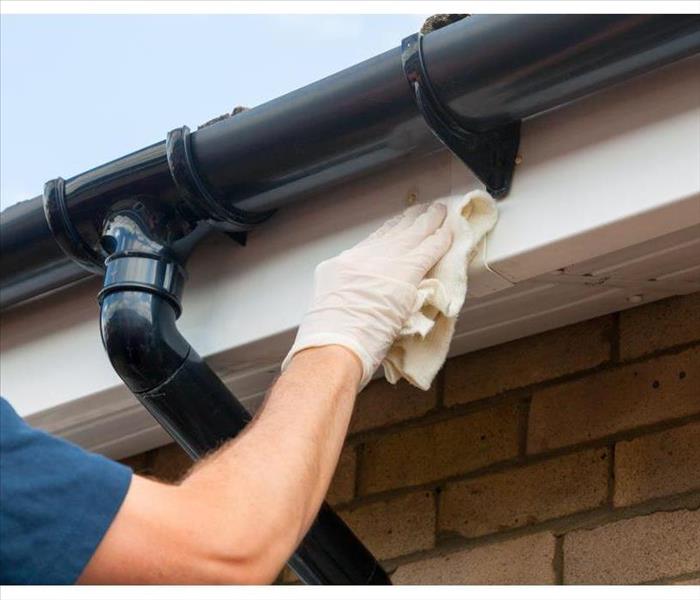 Keep your gutters clean.
Keep your gutters clean.
Prevent Flooding at Your Business
After a long winter, it is finally time to start planning for the warmer months ahead. If you own a business in Lafayette, LA, spring can be a busy season for profits, but it also is a busy season for flooding. Fortunately, there are things you can do to prevent problems during the next thaw. Follow these steps to reduce the chances of needing to hire a water damage restoration professional once the weather warms up.
1. Relocate Snow
Never underestimate the water capacity in a pile of snow. For this reason, you will want to clear away from the building's foundation. Ideally, snow should be at least three to five feet away, but the further away it is, the better.
2. Clean Out Gutters
After dealing with the snow, you will need to look up. Over a long winter, gutters can collect a large amount of debris. Leaves, sticks and dirt can lead to blockages which can force water to seep into the building.
3. Make Repairs
Next, look around the property. Few things lead to flooding like a frozen pipe. Check plumbing carefully. Seal leaks and insulate exposed pipes. While making repairs, do not forget the foundation. If you see cracks, do not ignore them.
4. Optimize Landscape Drainage
How does water drain around the building? If necessary, regrade the surrounding land to allow for better drainage. You may need to move plants and soil to do this, but it can be worth it.
5. Consider a Professional Inspection
If you are still feeling unsure about how your building will hold up to this spring's thaw, scheduling an expert inspection can give you peace of mind. Sometimes, it is just better to know.
When the weather finally warms up, your business should experience spring profits, not a spring flood. By following these steps, you can reduce the chances of encountering common flooding problems.
How Pretesting Speeds Up the Claims Process After a Home Disaster
2/23/2022 (Permalink)
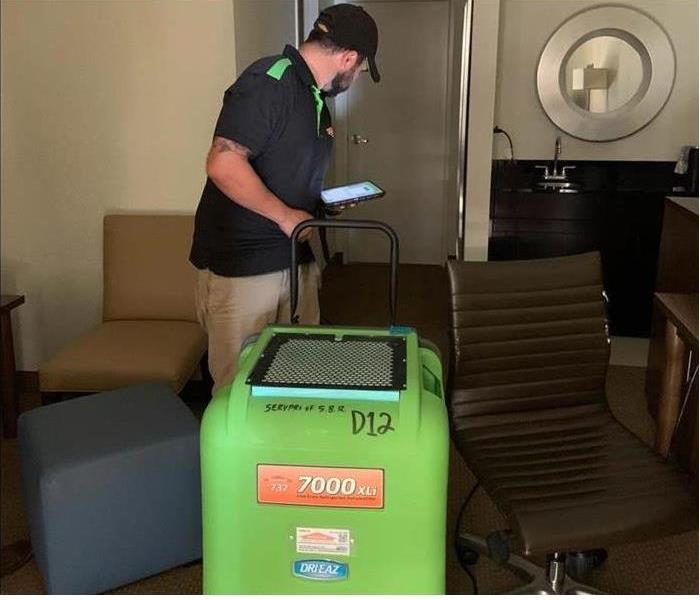 SERVPRO’s commitment to pretesting makes the restoration and insurance process more efficient.
SERVPRO’s commitment to pretesting makes the restoration and insurance process more efficient.
How Pretesting Aids In The Claims Process Following A House Fire
Following a disaster in your home, you have many concerns. One of the most important elements of getting back to your normal activities is starting the insurance process and making sure your coverage takes effect and that you aren’t stuck with massive costs. When you hire the right disaster cleanup team, you can count on your claim going through in a timely manner. The best restoration teams use pretesting and other practices to give you the peace of mind you need.
What Is Pretesting?
There is no shortage of disaster relief companies you could hire to help get you back on your feet after a fire, flood or mold infestation. You want to work with someone that does pretesting. This involves the following steps:
- Evaluating the full extent of the disaster.
- Making a plan of how to move forward in the best manner possible.
- Determining what parts of the home professionals can repair and salvage and what parts they must replace altogether.
Why Pretesting Matters to Insurance Company
You should make an insurance claim as quickly after the incident as possible. Cleanup and repair can be costly, but your coverage should take care of most of these costs. However, slow response from your disaster relief company can also bog thing down on the insurance company’s end. SERVPRO’s pretesting methods gets things in motion with the claims process and helps the insurance agent to his or her part to initiate coverage and payment.
Cost Benefit for You
With pretesting, the insurance company has confidence that it has an accurate picture of the full extent of the damage at your Lafayette, LA, home. This will ensure that the team does the work it should—not handling more or less than is necessary.
As if suffering damage and loss from a fire or flood isn’t difficult enough, you don’t want to get stuck with a slow and costly claims process. SERVPRO’s commitment to pretesting makes the restoration and insurance process more efficient.
5 Tips for Preventing Your Pets from Starting a House Fire
2/23/2022 (Permalink)
 If your home or business suffers from a fire damage event, don't wait! Give SERVPRO a call as soon as possible for your restoration and cleanup needs.
If your home or business suffers from a fire damage event, don't wait! Give SERVPRO a call as soon as possible for your restoration and cleanup needs.
5 Ways To Keep Your Pets From Starting A Fire At The House
If you have any pets in your home in Lafayette, LA, you need to take specific steps to ensure their safety and prevent a possible fire emergency. While you might assume your pets would naturally stay away from flames or behave themselves when you’re away, animals can harm themselves due to their curiosity. Even if your pets are able to escape safely, your home will need to go through some serious home fire restoration to get back to normal! Keep your home and your pets safe with these 5 tips!
1. Put Out Flames
Never your leave your pet unsupervised with an open flame. Always make sure to put out candles, fireplaces, stove tops, and any other open flames in your home before leaving them in a room by themselves.
2. Protect Your Stove
Some cats and dogs will jump or climb on the stove when you’re away, especially if they can smell some leftover food on countertops. Remove your stove knobs or buy covers to protect them as an important pet preparation step!
3. Cover Your Fireplace
Your curious dog or cat might not understand that a lit up fireplace means danger! Ensure your pet’s safety by getting a metal or heat-tempered glass screen for the fireplace when it’s lit up.
4. Consider Candle Alternatives
Even while your home, cats and dogs can easily accidentally knock over candles while they play or move their tails. Avoid this common fire emergency by using battery power candles, diffusers, or other alternatives.
5. Hide Wires
Some pets will chew on wires that are exposed. This is especially true of young puppies. Figure out ways to hide wires or unplug them and make them inaccessible when you’re not at home.
Prevent a fire emergency caused by your pet by following these five tips! Your pet’s curiosity and lack of awareness of their surroundings can get them into trouble, so it is important you create a space that is safe.
Tips for Commercial Roof Upkeep
2/23/2022 (Permalink)
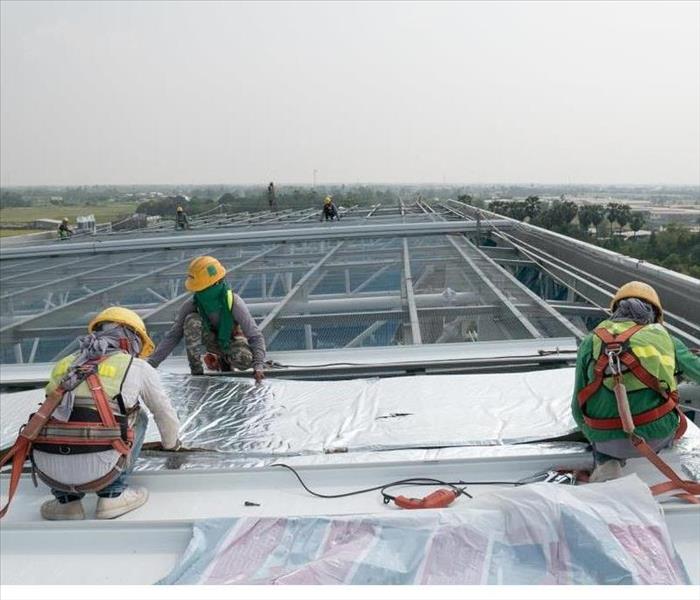 Keeping your gutters and storm drains clear ensures your roof drains any runoff properly.
Keeping your gutters and storm drains clear ensures your roof drains any runoff properly.
Commercial Roof Maintenance Suggestions
You rely on your roof to protect your business, but your roof relies on you to protect it from the hazards of the elements in Lafayette, LA, with proper commercial roof upkeep, maintenance, and repair. You can spring a roof leak just from weathering over time, or from wind damage. Here are just a few tips to keep your roof watertight, intact, and ready to stand up to anything:
- Create a repair plan. Your first step in roof upkeep is to have a repair plan before the first roof leak happens. Don’t get caught off guard. Ensure you have the numbers for your insurance company and repair technicians on hand, and have any materials needed in place to implement a temporary leak stopper until professionals can repair it.
- Inspect after major weather events. Hailstorms, thunderstorms, hurricanes, and windstorms are your most likely culprits for weather damage, but even earthquakes can cause cracks or lost shingles on your roof. After events, conduct a thorough inspection of your rooftops.
- Clean your gutters and storm drains. Keeping your gutters and storm drains clear ensures your roof drains any runoff properly. Without proper drainage, standing water can easily cause long-term damage to your roof.
- Keep trees and other foliage clear. Not only can falling branches damage your roof and cause a roof leak, but branches and vines lashed in the wind can rip off sections of your roof or cause abrasive damage. Avoid this by trimming all foliage and trees to a clearance of a certain distance around your building’s roof.
- Inspect indoors for any tell-tale signs. Sometimes, leaks may not be readily apparent from an outside inspection. Dark spots and water spots on the ceiling, as well as problems with interior systems, may be your warning signs. Conduct periodic inspections to identify any issues early on.
Prevent a problem before it happens by taking proper care of your roof. You can also contract professionals to help check for wind damage and to weatherproof your roof to prevent future costly mishaps.
A Quick Guide to Commercial Storm Insurance
2/3/2022 (Permalink)
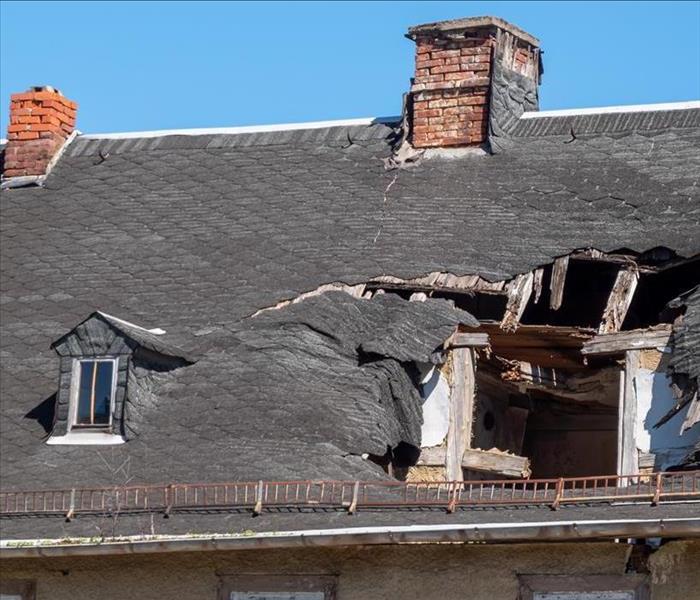 Severe winds can cause damage to your property.
Severe winds can cause damage to your property.
As a business owner in Lafayette, LA, insuring your property is a no-brainer. However, not all people know specifically how storm insurance works or what it covers. Here are some brief tips to help you understand this often-misunderstood type of insurance coverage.
Categories of Coverage
Not all storms, or deductibles, are created equal. The best way to understand your specific coverage is to read your commercial insurance policy or speak with the agent. Generally, insurance policies reference these three categories:
• Windstorm – This includes any damage to the property resulting from wind or hail that does not fall into one of the other categories.
• Hurricane – The definition of a hurricane differs by state and storm insurance company. Some define it by wind speed; others consider the amount of time between the National Weather Service (NWS) announcement and the time of the damage.
• Named Storm – When a tropical storm is severe and widespread, the NWS names it. For some insurance coverage, this may fall into the hurricane category.
Differences in Deductibles
When you first buy property insurance, you consider your deductible. This is the amount of money that you, the business owner, must pay out of pocket prior to receiving insurance funds. When the damage is the result of a natural disaster, however, people are often surprised that the same deductible does not apply. Instead of a standard amount of money, coverage is a percentage of the total cost for storm restoration professionals to mitigate and repair the damage. A typical rate is between one and five percent.
Whether severe winds in Lafayette, LA, knocks a tree into your commercial building or a hurricane causes significant destruction, understanding storm insurance is critical to getting your business up and running again. When the unexpected happens, take comfort in the notion that your insurance agent and local restoration company are Here to Help.
Answers to Basic Questions About Interruption Insurance
1/30/2022 (Permalink)
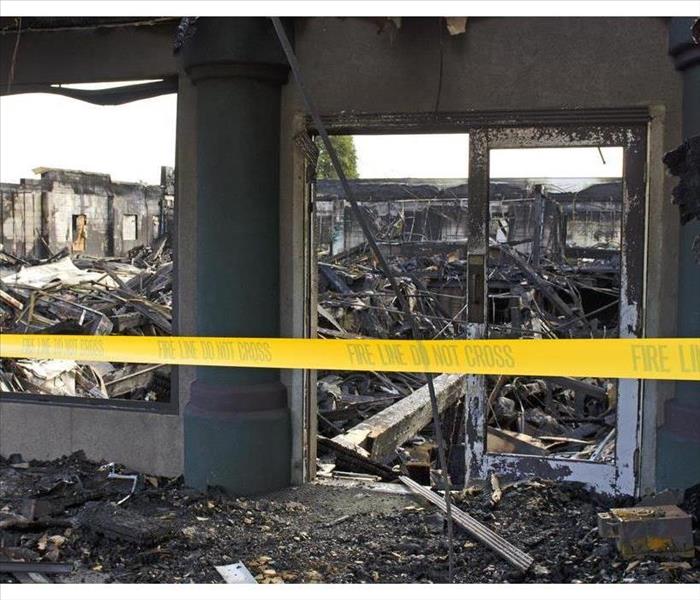 Commercial fire damage in Lafayette, LA.
Commercial fire damage in Lafayette, LA.
Protect Your Business With Interruption Insurance
Even if you've taken all the appropriate steps, your Lafayette, LA, business could still be affected by fire. When this happens, one of the most worrying aspects of the situation is how much money you could lose because of business interruption. Fire isn't the only emergency that could put your business in danger; other financial perils could include extreme weather, hail, windstorms, tornadoes, flooding, and other circumstances that may temporarily close your business. Protect your business with interruption insurance.
What Is Included in the Coverage?
Standard property insurance covers a lot of the physical damages and losses that fire leaves behind, but it doesn't cover everything. There are three main things that business interruption policies cover that your property insurance probably won't.
- Profits you would have earned during the time period
- Operating expenses you're still obligated to pay, such as rent
- Moving costs to your temporary location
Sometimes this type of insurance is called business income insurance.
Who Qualifies for Coverage?
Sadly, there are business owners who don't qualify for this protection. One of the primary qualifications for this type of insurance is a dedicated commercial location. If you run a small business out of your home, you probably won't qualify for the policy. However, you may be able to get a business owner's policy. Other aspects of your business that may affect your eligibility include the type of industry, your history of business interruption claims, and the location.
How Long Does the Interruption Coverage Last?
Fortunately for many business owners, interruption insurance is available for the entire period of restoration. This is defined as the length of time necessary for repairing, rebuilding, and replacing any of your property that is damaged or destroyed. It's a good idea to find out exactly what is covered before you talk to the fire restoration professionals.
As you put safety procedures in place and provide training for your employees, don't forget to research interruption insurance in Lafayette, LA. You'll want the peace of mind that comes from knowing your business won't fail when disaster strikes.
Tips for Avoiding Secondary Damages After Flooding
1/17/2022 (Permalink)
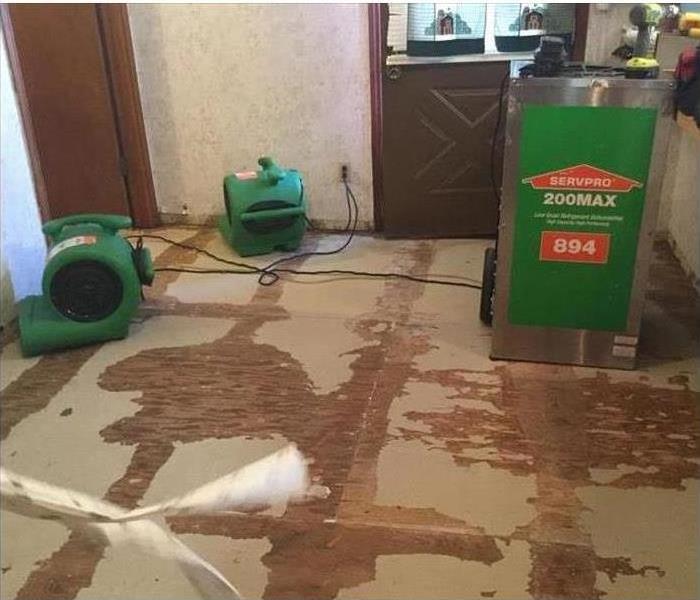 High-volume dehumidifiers and powerful fans are necessary tools for quickly and thoroughly drying rooms affected by flooding.
High-volume dehumidifiers and powerful fans are necessary tools for quickly and thoroughly drying rooms affected by flooding.
Preventing Further Damage After Flooding
When your home is affected by flooding from a winter storm or a broken pipe, secondary damage is a very real concern. As high humidity spreads throughout the residence, the chances of black mold taking hold and porous materials in your home absorbing moisture increase. Responding to flooding immediately is crucial to preventing further damage.
Commercial-Grade Equipment
Whether you involve a Lafayette, LA, flood damage cleanup company or try to tackle the situation on your own, you will need to use commercial-grade drying equipment. There are several reasons for this.
- Your home's air conditioner isn't strong enough to handle the additional moisture.
- The longer it takes to thoroughly dry your home, the more at risk you are of facing black mold damages.
- You'll get back to your normal routines more quickly.
Secondary Damages
Additional damages after flooding include the growth of mold behind drywall, in the attic, below carpeting, and in hidden corners. High levels of moisture can lead to weakening in the materials used to build your home, including wood, insulation, and cabinetry. In addition to long-term negative effects, your costs and losses could be increased when water extends from the initial affected area. As water spreads under doors and through walls, it reaches areas of the home that could have been protected. Removing water and drying the area thoroughly is the best way to avoid the spread of damages.
Water Removal Technicians
High-volume dehumidifiers, specialized heaters, and powerful fans are necessary tools for quickly and thoroughly drying rooms affected by flooding. Professional flood damage restoration technicians have the training and experience to set the equipment up for quick results. Experienced workers are often willing to share tips for avoiding problems such as recurring leaks or flooding.
Takeaway Tips
Remember, you need to act immediately. Powerful commercial-grade tools are essential for preventing secondary damages, such as black mold. Hiring Lafayette, LA, professionals is a great way to enjoy long-term protection for the well-being of your home and the health of your family.
Storm Preparation: Steps To Take To Protect Your Home From Storm Damage
1/10/2022 (Permalink)
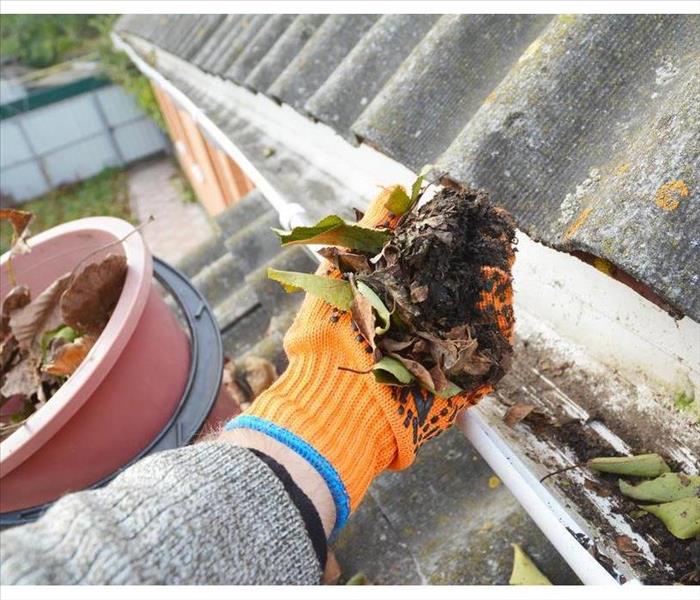 Keep your gutters clean.
Keep your gutters clean.
Protect Your Home From Flooding
With storm season well under way, you need to take active measures to protect your home from flooding and storm damage, if you have not already done so. Depending on where you live, preparation measures may look slightly different. That said, there are certain measures that all homeowners across the country can take to reduce their risk of excessive damage and the need for costly repairs. Those include the following:
- Clean out the gutters.
- Trim trees and overhanging branches.
- Install a sump pump.
- Install storm shutters.
- Invest in a generator.
- Invest in flood damage insurance.
- Prepare an emergency preparedness kit.
By doing each of the above, you can protect both your home and yourself in the event of a bad storm.
There Are Some Storms For Which You Just Cannot Prepare
By taking many of the above measures, such as cleaning out your gutters, trimming branches that overhang your home and installing storm shutters, you can keep the worst of wind, rain, snow and hail damage at bay. However, there are some types of damage, such as flooding, that you cannot fully protect against. Though sump pumps and other anti-flood measures help to an extent, they're not always 100 percent effective. If your home does flood, you want to act as soon as possible to prevent further damage. Some things you can do include the following:
- Elevate any furniture in the affected area.
- Turn off power to the affected area.
- Remove any valuables from the affected area.
- Take pictures of the damage and contact your insurance company.
- Reach out to your Lafayette, LA, flood damage remediation team for immediate assistance.
A restoration team can help dry out your home, clean your household items and perform mold remediation, if necessary. It is important that you contact your flooding team ASAP, as the longer you wait to remediate the damage, the worse the secondary damage, such as mold and rot, will become.





 24/7 Emergency Service
24/7 Emergency Service

































